
- •Preface
- •Introduction
- •Stereochemical Requirements for Cannabimimetic Activity
- •Molecular Determinants for Cannabinoid Activity: Refinement of a Molecular Reactivity Template
- •Interactions of Cannabinoids With Membranes. The Role of Cannabinoid Stereochemistry and Absolute Configuration and the Orientation of Delta-9-THC in the Membrane Bilayer
- •The High Affinity Cannabinoid Binding Site in Brain: Regulation by Guanine Nucleotides and Isolation of an Endogenous Inhibitor
- •Regulation of Adenylate Cyclase in a Cultured Neuronal Cell Line by Marijuana Constituents, Metabolites of Delta-9-tetrahydrocannabinol, and Synthetic Analogs Having Psychoactivity
- •Inhibitory and Stimulatory Effects of Cannabinoids on Eicosanoid Synthesis
Molecular Determinants for Cannabinoid Activity: Refinement of a Molecular Reactivity Template
Patricia H. Reggio, Ph.D.
INTRODUCTION
Numerous studies of structure-activity relationships (SARs) in the cannabinoid series have been published; e.g., see review by Sofia (1978) and some more recent work by Martin et al. (1984a, 1984b) and Narimatsu et al. (1985). An observation which emerges from a review of all of these studies is that some cannabinoids can be structurally dissimilar as in delta-9-tetrahydrocannabinol (delta-9-THC) and Abbott 40656 (Rosell et al. 1979) and yet can have similar activities; whereas others, which show only slight structural differences as in 10- alpha-OH-delta-8-THC and 10-beta-OH-delta-8-THC (Edery et al. 1971). can exhibit dramatic activity differences (figure 1). This observation emphasizes that a common basis for the activity of these compounds must be sought in more than their mere three-dimensional structures.
Traditionally, cannabinoid SARs have been focused almost entirely on the independent contribution of certain structural groups ("functional groups") of the molecules. These SARs have been compiled into extensive "lists of requirements" (Razdan 1984). Certain regions or conformations of the molecules have been proposed to be important. These regions or conformations include a methyl group in the plane of the aromatic ring, a free phenol, and a free C-4(C-5’) aromatic position (Edery et al. 1971); the phenolic hydroxyl group (Uliss et al. 1975); the side chain (Osgood et al. 1978); nonplanarity (Binder et al. 1979); and planarity of the molecule (Burstein et al. 1983). Stereoselectivity in the activity of the tetrahydrocannabinols has been reported (Dewey et al. 1984). This type of approach in SAR studies often assumes the following: that functional groups must react directly with specific sites in the receptor, that modification of one group does not affect the reactivity of another, and that geometric and stereometric factors, such as distance and spatial relationships between functional groups, are all important. Such focus on isolated aspects of the cannabinoids ignores the fact that the molecular properties that are directly responsible for the molecular interactions (that lead to the pharmacological effect) are encoded in the entire molecular structure. To date, no characterization of the entire molecule and correlation of this characterization with activity has been attempted in the cannabinoid field.
The importance of quantum chemical methods in describing the physical and chemical properties of molecules is evident in every facet of modern chemical
82
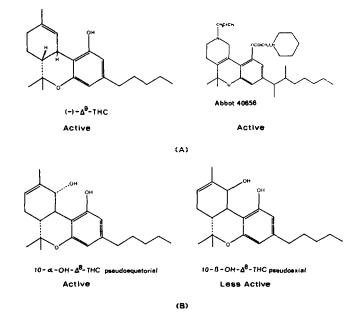
FIGURE 1. Cannabinoids (a) which are structurally dissimilar yet exhibit similar activities, and (b) which are structurally similar yet exhibit different activities. From Reggio and Mazurek 1987. Copyright 1986 by Elsevier Science Publishers B.V. (Amsterdam).
research and is very well documented. In the study of biological systems, experimental data must be obtained in a variety of forms and from many different sources. The value of quantum chemical approaches to the study of biological systems is in an ability to analyze, interpret, and rationalize all experimental observations on molecular processes in a unified language based on the primary principles of physics. Considerable evidence exists proving the relative success of theoretical approaches. These approaches have elucidated specific mechanisms of drug action, have provided a basis for rational drug design, and have led to conclusions about the nature of drug-receptor interactions (Dearden 1983; Vida and Gordon 1984). We have used theoretical approaches to successfully describe the molecular determinants for binding of methylenedioxytryptamines at SHT/LSD receptors (Reggio et al. 1981) and have
also used theoretical approaches to explain the role that tautormerism plays in the activation of the histamine-H2 receptor by 2-methyl and 4-methylhistamine (Reggio and Mazurek 1987). The basic assumption in any of these theoretical studies of drug action is that the interaction between drugs and their biological targets is dependent on the same molecular parameters that determine chemical interactions and reactions. Molecular Reactivity Characteristics (MRCs) such as molecular electrostatic potentials (MEP), polarizabilities, and proton affinities are molecular properties that determine specific chemical reactivity. In theoretical studies of structure-activity relationships, such MRCs are used to establish how the information necessary for receptor recognition and activation is encoded in the molecular structure of the drug.
83
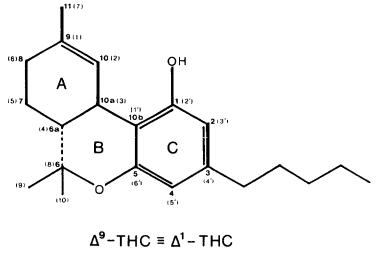
Despite the extensive application of theoretical methods in the study of many pharmacological systems, very little attention has been focused on the cannabinoids to date. Those theoretical studies on cannabinoids which have been published have not focused on the calculation of molecular reactivity characteristics. Most of these studies have concentrated on the calculation of conformation in an attempt to predict the most probable geometry (lowest energy conformer) and its relation to activity. The structures and energies of delta-9- THC and three other cannabinoids obtained by Westheimer calculations and extended Huckel molecular orbital calculations have been reported (Archer et al. 1970). Theoretical studies of cannabinoids with analgetic and anticonvulsant activity have also been reported (Johnson et al. 1982; Tamir et al. 1980). The work presented here extends beyond the considerations which have prevailed in theoretical studies of the cannabinoids. The aim of this work is to reveal elements of molecular reactivity that are related to psychopharmacological activity.
A major step in identifying the MRCs necessary for cannabinoid activity was to select a template molecule (a molecule with demonstrated activity whose MRCs can be used as a basis for comparison with those of other cannabinoids). Since (-)trans-delta-9-THC (delta-9-THC) has been reported to be the major psychoactive component of cannabis (Gaoni and Mechoulam 1964, 1971) and since studies indicate that it can exert behavioral effects without metabolic activation (Carney et al. 1979), delta-9-THC was chosen as the template molecule for this study. Figure 2 illustrates the numbering systems which are commonly employed in the literature for delta-9-THC.
FIGURE 2. An illustration of the two numbering systems which are commonly employed for the cannabinoids. From Reggio and Mazurek 1987. Copyright 1986 by Elsevier Science Publishers B.V. (Amsterdam).
84
Our first working hypothesis deals with two components of the delta-9-THC structure which confer reactivating characteristics upon the molecule that are crucial to activity. These components are the lone pairs of electrons of the phenol oxygen (these lone pairs generate reactivity properties dependent on the orientation of the OH bond relative to the carbocyclic ring, Ring A), and the orientation of the carbocyclic ring, Ring A (this ring and its orientation generate hydrophobic properties). The spatial arrangements of these reactivity characteristics are the components of the template to which the characteristics of other cannabinoids can subsequently be compared.
Template for Cannabinoid Activity
Recently, we reported the characterization of the template molecule delta-9-THC (Reggio and Mazurek, 1987). Since the molecular reactivity characteristics of delta-9-THC are to be used as a basis of comparison with other cannabinoids, the essential features of the template are presented here. The reader should refer to the original paper (Reggio and Mazurek 1987), however, for all calculational details.
The lowest energy conformer of delta-9-THC as obtained by conformational analysis is shown in figure 3. It is clear from this figure that delta-9-THC is a nonplanar molecule. The carbocyclic ring (Ring A) of delta-9-THC exists in a half-chair conformation. Ring B assumes a conformation such that the axial C6
methyl group is on the same side of the molecule as H10a and is much closer to H10a than is the other methyl group. In this optimized structure, the phenolic
hydrogen points away from the carbocyclic ring (dihedral angle, C2-C1-0-H = - lo). Figure 4 shows a different perspective of the molecule. Here, delta-9-THC is shown in the direction parallel to the vector from C2 to C10b.From this perspective, the conformation of the carbocyclic ring (Ring A) causes the top part of the ring to move to the left, thus permitting no protrusion of Ring A into the bottom face of the molecule. It is part of our working hypothesis that this orientation is necessary for cannabinoid activity. The conformation of the carbocyclic ring may allow for nondirectional hydrophobic interactions.
The lone pairs of electrons of the phenol oxygen generate directional reactivity properties dependent on the orientation of the OH bond relative to the carbocyclic ring. Studies of molecular energy as a function of rotation about the C1-O axis reveal that two minimum energy conformations of the phenolic OH exist. In Conformation I, the phenolic OH is slightly bent out of the plane of the aromatic ring with the hydrogen pointing away from Ring A (C2-C1-O-H dihedral angle,  = -1°). In Conformation II, the phenolic hydrogen is below the plane of the aromatic ring and is pointing toward Ring A (
= -1°). In Conformation II, the phenolic hydrogen is below the plane of the aromatic ring and is pointing toward Ring A (  = 155°). The conformation of the rest of the molecule remains essentially unchanged.
= 155°). The conformation of the rest of the molecule remains essentially unchanged.
The molecular electrostatic potential (MEP) is a molecular reactivity characteristic that determines specific chemical reactivity. It is an important determinant of drug action. The electrostatic potential field extends into space and influences nearby molecules. Unless the fields of a drug and its receptor are complementary, they will not attract or bind to one another. Indeed, electrostatic forces appear to guide an incoming drug into its receptor site and align so that shorter range binding forces can take effect (Tucker 1984). Therefore, a very direct indication of the nature and extent of electrostatic drug-receptor interactions can be obtained by mapping the potential generated by a molecule.
85
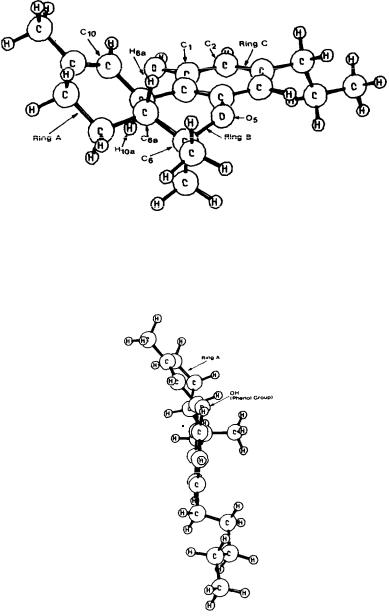
FIGURE 3. Conformation of delta-9-THC (with propyl side chain) as determined by MM2. From Reggio and Mazurek 1987. Copyright 1986 by Elsevier Science Publishers B.V. (Amsterdam).
FIGURE 4. Conformation of delta-9-THC as determined by MM2: here the perspective of Ring A is viewed in the direction parallel to the vector from C2 to C10b . From Reggio and Mazurek 1987. Copyright 1986 by Elsevier Science Publishers B.V. (Amsterdam).
86
The calculated electrostatic potential patterns generated by the bottom face of delta-9-THC in each of its minimum energy conformers are shown in figures 5 and 6. These patterns are composed of lines of equipotential energy in kcal/mole that would be felt by a test positive charge placed at any specified point on the map. Figures 5 and 6 illustrate the regions of negative potential in planes parallel to the benzene ring at distances of 1.5 Ås below the plane of the ring. Because delta-9-THC is a nonplanar molecule. the MEPs differ depending upon whether the molecule is viewed from above or below. We found that the change in the position of the phenol group from Conformation I to Conformation II caused a distinguishable difference in the MEPs of the two conformers when viewed from the bottom face.
At this stage of the investigation, it was impossible to identify which conformation of the phenolic OH of delta-9-THC (I or II) was more relevant at the site of action. Hence, the MEPs shown in figures 5 and 6 along with the conformation of Ring A, as illustrated in figure 4, formed the preliminary set of molecular reactivity characteristics for cannabinoid activity.
Refinement of the Template
In order to refine our template, a comparison of the MRCs of delta-9-THC with those of another cannabinoid was undertaken. Edery et al. (1971) reported that in rhesus monkey behavioral tests the replacement of the phenolic hydrogen of delta-9-THC with a methyl group renders the molecule inactive. This inactive cannabinoid, O-methyl-delta-9-THC (figure 7), was selected for comparison in order to assess the importance of the position of the lone pairs of electrons of the phenol oxygen. We report here the results of our comparison of the properties of O-methyl-delta-9-THC with those of the delta-9-THC reactivity template.
METHODS OF PROCEDURE
Conformational Study of O-Methyl-Delta-9-THC
The first step in the characterization was the conformational analysis of O- methyl-delta-9-THC. The force field or molecular mechanics method as encoded in the program MM2 (Allinger and Yuh 1980) was used in this analysis. The force field available in MM2 has been parameterized for oxygen containing molecules and has proven satisfactory for the calculation of structures and energies of oxygen containing compounds (Allinger et al. 1980). The X-ray structure of delta-9-THC Acid B (Rosenquist and Ottersen 1975) was used to obtain an input geometry (i.e., bond lengths, bond angles, and dihedral angles for the fused ring skeleton of delta-9-THC). Necessary atoms were added to this skeleton at standard bond lengths and bond angles (Mitchell and Cross 1965) to produce an input geometry for O-methyl-delta-9-THC in the MM2 calculation. In the calculational scheme for the template molecule, delta-9-THC, molecular size constraints necessitated reducing the pentyl side chain to propyl (Reggio and Mazurek 1987). In order to maintain consistency, the side chain in O-methyl- delta-9-THC was also reduced to propyl. Such a modification was acceptable since the focus of this study is on the fused ring structure and the phenol group and not on the side chain.
Because the position of the methoxy group was very important to our working hypothesis, two studies of the molecular energy as a function of rotation about the C1-O axis were conducted. In the first study, the dihedral driver option in
87
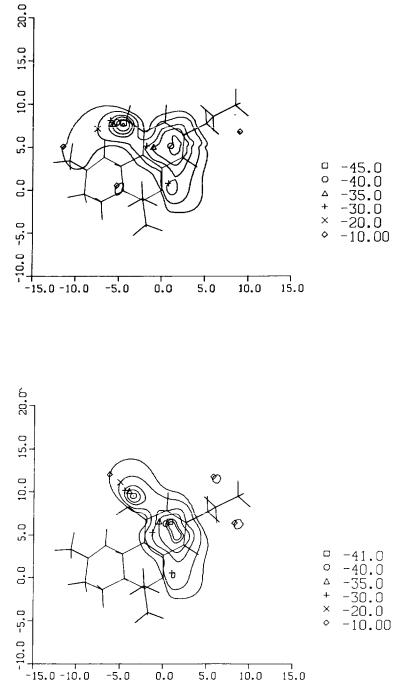
FIGURE 5. Molecular electrostatic potential of the bottom face of delta-9-THC (Conformational I). Contours represent the MEP in a plane 1.5Å below the aromatic ring. Values are in Kcal/mole. From Reggio and Mazurek 1987. Copyright 1986 by Elsevier Science Publishers B.V. (Amsterdam).
FIGURE 6. Molecular electrostatic potential of the bottom face of delta-9-THC (Conformational II). See figure 5 for details. From Reggio and Mazurek 1987. Copyright 1986 by Elsevier Science Publishers B.V. (Amsterdam).
88
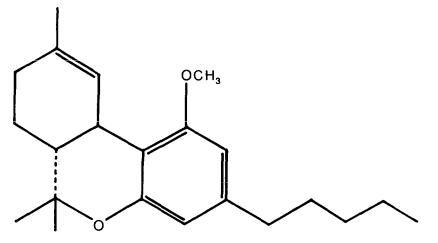
FIGURE 7. O-methyl-delta-9-THC
the MM2 program (Allinger and Yuh 1980) was used. Rotations in 36 steps were made about the C1-O axis.
In the second study, an SCF calculation was performed for a model fragment of O-methyl-delta-9-THC (see figure 8). The Gaussian 80 system of programs and the STO-3G basis set were employed here (Fluder et al. 1980). Initially, all atoms in the fragment were frozen in their optimized positions. These positions were determined by MM2 calculations for the full molecule. Rotations of the methoxy group in 18 steps were made about the C1-O axis.
RESULTS AND DISCUSSION
Conformational Analysis
Figure 9 shows the minimum energy conformer of O-methyl-delta-9-THC as obtained from the MM2 calculation. Previous studies have predicted that the cyclohexene ring (Ring A) of delta-9-THC should exist predominantly in a half- chair-like conformation (Archer et al. 1970). The present calculations indicate that Rng A retains this conformation in O-methyl-delta-9-THC. As a result of the interaction between the C6 methyl groups and H6a , Ring B assumes a conformation such that the axial C6 methyl group is on the same side of the molecule as H10a and iS much closer to H10a than is the other methyl group. The substituents on C6 and C6a are staggered with respect to one another (optimized C10a -C6a -C6 -O5 dihedral angle is 63°). Here, the numbering system employed is the same as that for delta-9-THC (see figure 2).
The C1 methoxy group is subject to steric interaction with the C10 proton. This interaction causes the methoxy oxygen to bend slightly out of the plane of the benzene ring. The methoxy group optimizes at a position away from Ring A (optimized C2-C1-O-C dihedral angle is -5°).
89
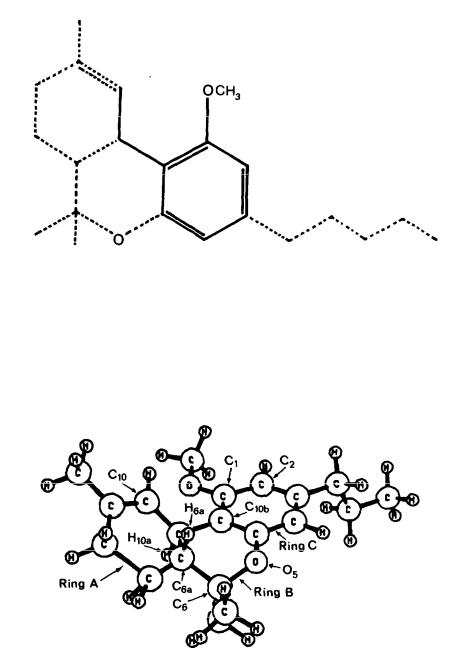
FIGURE 8. Model fragment for O-methyl-delta-9-THC.
FIGURE 9. Conformation of O-methyl-delta-9-THC (with propyl side chain) as determined by MM2.
90

Optimized bond lengths are within .01 Å of the following values: Csp P2-Csp2
1.40Å, Csp 2-Csp3 1.51 Å, Csp 3-Csp 3 1.54 Å, Csp2-O 1.37 Å, Csp3-O
1.41Å, Csp2-H 1.10 Å, and Csp3-H 1.11 Å.
Figure 10 shows a perspective of the molecule viewed in the direction parallel to the vector from C2 to C10b From this perspective, the conformation of Ring A causes the top part of the ring to move to the left, thus permitting no protrusion of Ring A into the bottom face of the molecule. A comparison of figure 10 with figure 4 reveals that the position of Ring A in O-methyl-delta-9-THC mimics that of Ring A in delta-9-THC.
The results of the MM2 study of molecular energy as a function of rotation about the C1-O axis are summarized in figure 11. There are local minima at  = -500 and 85° separated by a 0.8 kcal barrier. The SCF results for the model fragment of O-methyl-delta-9-THC agreed very well with those above. The SCF method pinpointed two minimum energy conformers
= -500 and 85° separated by a 0.8 kcal barrier. The SCF results for the model fragment of O-methyl-delta-9-THC agreed very well with those above. The SCF method pinpointed two minimum energy conformers  = -5° and
= -5° and  = 85° separated by a 1.0 kcal barrier.
= 85° separated by a 1.0 kcal barrier.
It is clear from figure 11 that a  of 155° (which corresponds to Conformation II of delta-9-THC) does not represent an energy minimum for the molecule. In
of 155° (which corresponds to Conformation II of delta-9-THC) does not represent an energy minimum for the molecule. In
fact, in the MM2 study, the conformation with |
= 155° is 7.3 kcal higher in |
energy than the minimum energy conformer |
of O-methyl-delta-9-THC. |
In its minimum energy conformation, the methoxy group of O-methyl-delta-9- THC essentially adopts Conformation I of the template. In this conformation, the lone pairs of electrons of the phenol oxygen are directed toward Ring A. However, the methoxy group cannot mimic Conformation II of the template in which the lone pairs of electrons of the phenol oxygen are directed away from Ring A. On the basis of these results, the inactivity of O-methyl-delta-9-THC can be explained by the fact that the molecule cannot mimic Conformation II of delta-9-THC. These results seem to indicate, then, that it is Conformation II which is the more relevant conformation at the site of action.
In an early SAR study, Edery et al. (1971) postulated the need for a free phenol for cannabinoid activity. Recently, Binder and Franke (1982) have proposed a picture of delta-9-THC interacting with its hypothetical receptor. In this picture, the phenolic hydrogen is shown to form a hydrogen bond with the receptor. Such a hypothetical drawing implies the necessity of a phenolic hydrogen for activity. It is possible to argue from this viewpoint that O-methyl- delta-9-THC is inactive due to its lack of a phenolic hydrogen. Although the demonstrated activity of some esterified THC would argue against the necessity of a phenolic hydrogen for activity, there appears to be no definitive compound yet synthesized which can answer this question. In the next stage of our investigation, we hope to propose new cannabinoids which could be useful in delineating an answer.
CONCLUSIONS
The finding that O-methyl-delta-9-THC cannot mimic Conformation II of delta- 9-THC in which the lone pairs of electrons of the phenol oxygen are directed away from Ring A has led to a refinement of our template for cannabinoid activity. This inability of O-methyl-delta-9-THC to mimic Conformation II may cause the inactivity of the molecule. As a result of this finding, we have tentatively refined our template for cannabinoid activity to include two aspects.
91
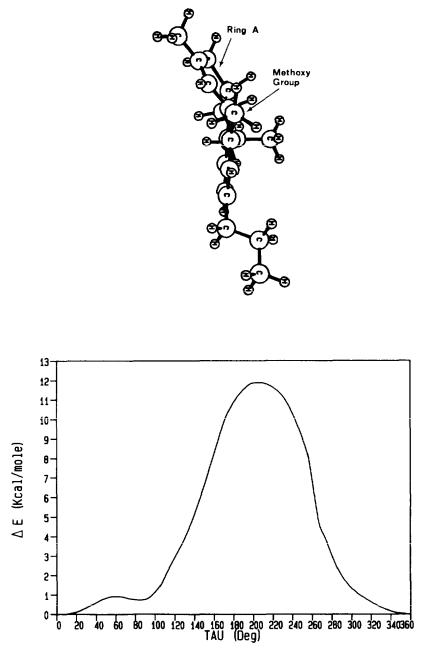
FIGURE 10. Conformation of O-methyl-delta-9-THC (with propyl side chain) as determined by MM2.
FIGURE 11. Conformation of O-methyl-delta-9-THC as determined by MM2: here the perspective of Ring A is viewed in the direction parallel to the vector from C2 to C1 O b .
92
1.The first aspect is the orientation of the lone pairs of electrons of the phenol oxygen such that these lone pairs point away from Ring A (Conformation II) (these lone pairs generate directional reactivity properties).
2.The second aspect is the orientation of Ring A such that the ring moves out of the bottom face of the molecule (this conformation is likely to allow for nondirectional hydrophobic interactions).
Further refinements of this template will be made in subsequent comparisons of the template MRCs with those of other cannabinoids.
REFERENCES
Allinger, N.L., and Yuh, Y.H. MM2. Ouantum Chemistry Program Exchange 13:395, 1980.
Allinger, N.L.; Chang, S.-H.; Glaser, D.H.; and Honig, H. An improved molecular mechanics force field for alcohols, and ethers. Isr J Chem 20:5156, 1980.
Archer, R.A.; Boyd, D.B.; Demarco, P.V.; Tyminski, I.J.; and Allinger, N.L. Structural studies of cannabinoids. A theoretical and proton magnetic resonance analysis. J Am Chem Soc 92(17):5200-5206, 1970.
Binder, M., and Franke, I. Is there a THC-receptor? In: Hucho, F., ed. Neuroreceotors. Berlin and New York: Walter de Gruyter, 1982. pp. 151161.
Binder, M.; Edery, H.; and Porath, G. Delta-7-tetrahydrocannabinol, a nonpsychotropic cannabinoid: Structure-activity considerations in the cannabinoid series. In: Nahas, G.G., and Paton, W.D.M., eds. Marihuana Biological Effects: Analysis, Metabolism, Cellular Responses, Reproduction, and Brain. Oxford: Pergammon Press, 1979. pp. 71-80.
Burstein, S.; Hunter, S.A.; and Ozman, K. XII. The effect of cannabinoid structure on the synthesis of prostaglandins by human lung fibroblasts. Mol Pharm 23:121-126, 1983.
Carney, J.M.; Balster, R.C.; Martin, B.R.; and Harris, L.S. Effects of systemic and intraventricular administration of cannabinoids on schedule-controlled responding in the squirrel monkey. J Pharmacol EXp Ther 210:399-404, 1979.
Dearden, J.C., ed. Ouantitative Approaches to Drug Design. Amsterdam: Elsevier, 1983. 296 pp.
Dewey, W.; Martin, B.; and May, E. Cannabinoid stereoisomers: Pharmacological effects. In: Smith, D.E., ed. CRC Handbook of Stereoisomers: Drugs in Psychopharmacology. Boca Raton: CRC Press, 1984. pp. 317-321.
Edery, H.; Grunfeld, Y.; Ben-Zvi, Z.; and Mechoulam, R. Structural requirements for cannabinoid activity. Ann NY Acad Sci 191:40-53, 1971.
Fluder, E.J.; Schlegel, H.B.; and Topiol, S.W. Gaussian 80 (IBM Version), unpublished, 1980.
Gaoni, Y., and Mechoulam, R. Isolation, structure, and partial synthesis of an active constituent of hashish. J Am Chem Soc 86:1646-1647, 1964.
Gaoni, Y., and Mechoulam, R. The isolation and structure of delta-1- tetrahydrocannabinol and other neutral cannabinoids from hashish. J Am Chem Soc 93:217-224, 1971.
Johnson, M.R.; Melvin, L.S.; and Milme, G.M. Prototype cannabinoid analgetics, prostaglandins and opiates - a search for points of mechanistic interaction. Life Sci 31:1703-1706, 1982.
93
Martin, B.R.; Harris, L.S.; and Dewey, W.L. Pharmacological activity of delta-g- THC metabolites and analogs of CBD, delta-8-THC and delta-9-THC. In: Agurell, S.; Dewey, W.L.; and Willette, R.E., eds. The Cannabinoids; Chemical, Pharmacologic, and Therapeutic Aspects. New York: Academic Press, 1984a. pp. 523-544.
Martin, B.R.; Kallman, M.J.; Kaempf, G.F.; Harris, L.S.; and Dewey, W.L. Pharmacological potency of R- and S-3’-hydroxy-delta-9- tetrahydrocannabinok Additional structural requirement for cannabinoid activity. Pharmacol Biochem Behav 21:61-65, 1984b.
Mitchell, A.D., and Cross, L.C., eds. Tables of Interatomic Distances and Configurations in Molecules and Ions, Special Publication No. 11, 1958; Special Publication No. 18, 1965.
Narimatsu, S.; Matsubara, K.; Shimoniski, T.; Watanabe, K.; Yamamoto, I.; and Yoshimura, H. Pharmacological activities in the mouse of delta-9- tetrahydrocannabinol metabolites oxidized at the 8-position. Chem Pharm Bull 33(1):392-395, 1985.
Osgood, P.R.; Howes, J.F.; Razdan, R.K.; and Pars, H.G. Drugs derived from cannabinoids. 7. Tachycardia and analgesia structure-activity relationships in delta-9-tetrahydrocannabinol and some synthetic analogues. J Med Chem 2(8):809-811, 1978.
Razdan, R.K. Chemistry and structure-activity relationships of cannabinoids: An overview. In: Agurell, S.; Dewey, W.L.; and Willette, R.E., eds. The Cannabinoids: Chemical, Pharmacologic, and Therapeutic Aspects. New York: Academic Press, 1984.
Reggio, P.H. and Mazurek, A.P. A molecular reactivity template for cannabinoid activity. J Mol Struc (Theochem) 149:331-343, 1987.
Reggio, P.; Weinstein, H.; Osman, R.; and Topiol, S. Molecular determinants for binding of methylenedioxytryptamines at 5HT/LSD receptors. Int J Quantum Chem QBS8:373-384, 1981.
Reggio, P.; Topiol, S.; and Weinstein, H. Molecular determinants for the agonist activity of 2-methylhistamine and 4-methylhistamine at H2-receptors. J Med Chem 29:2412-2415, 1986.
Rosell, S.; Bjorkroth, V.; Agurell, S.; Leander, K.; Ohlsson, A.; Martin, B.; and Mechoulam, R. Relation between effects of cannabinoid derivatives on the twitch response of the isolated guinea pig ileum and their psychotropic properties. In: Nahas, G.G., and Paton, W.D.M., eds. Marihuana Biological Effects: Analysis, Metabolism, Cellular Responses, Reproduction, and Brain. Oxford: Pergammon Press, 1979. pp. 63-70.
Rosenquist, E., and Ottersen, T. The crystal and molecular structure of delta-9- tetrahydrocannabinolic acid B. Acta Chem Scand 1329:379-384, 1975.
Sofia, R.D. Cannabis: Structure-activity relationships. In: Iverson, L.L.; Iverson, S.D.; and Snyder, S.H., eds. Handbook of Psychopharmacology. Vol . 12. Drugs of Abuse. New York: Plenum Press, 1978. pp. 319-371.
Tamir, I.; Mechoulam, R.; and Meyer, A. Cannabidiol and phenytoin: A structural comparison. J Med Chem 23:220-223, 1980.
Tucker, J.B. Designing molecules by computer. High Technology JAN:52-59, 1984.
Uliss, D.B.; Calzell, H.D.; Handrick, G.R.; Howes, J.F.; and Razdan, R.K. Hashish. Importance of the phenolic hydroxyl group in tetrahydrocannabinols. J Med Chem 18:213-215, 1975.
Vida, J.A., and Gordon, M. Conformationally Directed Drug Design. American Chemical Society Symposium Series 251. Washington: American Chemical Society, 1984. 271 pp.
94
ACKNOWLEDGMENTS
Dr. Harel Weinstein consulted on this project. This work was supported in part by grant DA-03934 from the National Institute on Drug Abuse and by a grant of computer time from from the University Computing Center of the City University of New York. Data analysis was done on the PROPHET computer system, a national computational resource sponsored by the NIH through the Division of Research Resources.
AUTHOR
Patricia H. Reggio, Ph.D.
Department of Chemistry
Kennesaw College
Marietta, Georgia 30061
95
Different Cannabinoids Exhibit
Different Pharmacological and
Toxicological Properties
Ralph Karler, Ph.D., and Stuart A. Turkanis, Ph.D.
INTRODUCTION
By the mid-1970s. the anticonvulsant properties of the cannabinoids were well documented (Loewe and Goodman 1947; Karler et al. 1973, 1974; Carlini et al. 1975; Consroe et al. 1976). but an analysis of their therapeutic potential as antiepileptics had not yet been carried out. For this reason, a major goal originally of our marijuana-related research was to determine the cannabinoids’ antiepileptic potential by the use of conventional laboratory tests for anticonvulsant and toxic properties (Turkanis and Karler 1981). The aim was to define the relative selectivity of desired-to-undesired effects of these agents. In the course of these studies, which involved many different cannabinoids, we observed that there exist among these drugs, not only quantitative differences, but also qualitative differences. The accretion of these differences ultimately provides a profile of the pharmacological characteristics of the cannabinoids as a class of drugs. The data presented below represent examples from our investigations of some properties of the cannabinoids, specifically related to their antiepileptic potential.
METHODS
The anticonvulsant characteristics were measured in a variety of tests in order to obtain a spectrum of properties for comparative purposes; the tests included both electroand chemo-shock tests. Because a major toxic effect of the clinical antiepileptics is central depression, neurotoxicity was determined in terms of motor toxicity, a classical measure of central nervous system (CNS) depression. The details of the anticonvulsant and motor-toxicity tests have been previously described (Karler et al. 1974; Turkanis et al. 1974).
The cannabinoids were dispersed in isotonic sodium chloride solution with the aid of Tween 80 and ultrasound (Turkanis et al. 1974), and all drug and vehicle preparations were administered intraperitoneally (i.p.). All determinations of potency were made from dose-effect curves, which were obtained at peak-effect times; and anticonvulsant potencies were expressed as either the effective-dose 50 (ED50) or the anticonvulsant-dose 50 (AD50), and motor toxic potency as the toxic-dose 50 (TD50).
96
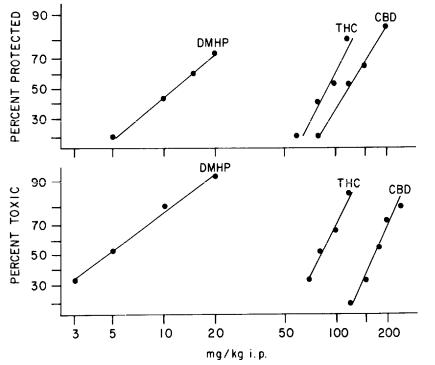
RESULTS
Figure 1 illustrates the dose-effect curves for anticonvulsant activity in a maximal electroshock (MES) test and motor toxicity in a bar-walk test.
FIGURE 1. Dose-effect relationships for cannabinoids in MES and bar-walk tests. The bar-walk test was carried out just prior to the MES test at the peakeffect times: THC and DMHP, 2 hr; CBD, 1 hr. The AD50s and their 95% confidence limits (mg/kg, i.p.) are 12 (8-19) for DMHP, 92 (74-115) for THC, and 122 (94-159) for CBD. The TD50s and their 95% confidence limits (mg/kg, i.p.) are 4.7 (3-7) for DMHP, 82 (66-103) for THC, and 170 (144-200) for CBD. Each point represents the results obtained jrom about 15 male Charles River mice (ICR) weighing 15-26 gm. AD50s and TD50s and their 95% confidence limits were calculated by methods described by Litchfield and Wilcoxon (1949). THC = delta-9-tetrahydrocannabinol; CBD = cannabidiol; DMHP = dimethylheptylpyran.
In this study, we compared DMHP, THC, and CBD. At the time, these three compounds were selected for our initial studies for a variety of reasons: THC was included because we intended to use it as the prototype cannabinoid; CBD was included because it lacks the psychotoxicity of THC; and, finally, DMHP was studied because it was thought to be the compound that had been tried with
97
apparently some success in epileptic children (Davis and Ramsey 1949). DMHP was later found, like CBD, to be nonpsychoactive in humans (Lemberger et al. 1974). In the upper half of this figure, we compared the dose-response curves for these three drugs against MES, which is one measure of anticonvulsant activity. Some points are clear from these data: first, that all three compounds were anticonvulsant in the MES test; second, that the psychotoxicity of THC is separable from the anticonvulsant activity because the nonpsychoactive CBD and DMHP are both anticonvulsant; and, finally, in terms of anticonvulsant potency, the dose-response curves illustrate that there is a big difference in potency between DMHP and the other two drugs.
The separation between psychoactivity and anticonvulsant activity encouraged us to continue this study and to pursue other aspects of the potential toxicity problem. One property that especially interested us was motor toxicity because all antiepileptic drugs are motor toxic. The lower half of the figure illustrates that the cannabinoids are also motor toxic, as measured in a bar-walk test; in these instances, potency in terms of motor toxicity appeared to be directly proportional to the anticonvulsant potency; that is, the greater the anticonvulsant potency, the greater the motor-toxic potency.
The data shown in table 1 represent the continuation of our study of relative potencies with respect to the anticonvulsant and toxic effects of a large number of cannabinoids. The drugs included in table I were not selected for their structural characteristics; rather, they were included in the study because they were the drugs that were available to us at the time. Nevertheless, the data shown illustrate that most of these compounds displayed both anticonvulsant and motor-toxic activity and that the potency relative to THC varied. For example, in the MES test, the 11-hydroxy derivative is about seven times as potent as is THC; and, similarly, it is about three or four times as potent in terms of motor toxicity. The remaining compounds listed in the table illustrate the quantitative differences in both anticonvulsant activity and motor toxicity, even in such a limited sample of cannabinoids. The anticonvulsant activity ranged from a fraction of that of THC, as illustrated by THC Acid B, to many times that of THC, as in the case of d,1,threo-DMHP. Similar ranges were observed for the motor-toxic activity in the bar-walk test.
At this point in our studies, one of the frequent criticisms that we received was that the anticonvulsant dose of THC in the mouse, about 100 mg/kg, is very high--approximately 100 times that of the psychoactive dose in humans; therefore, the meaning of the anticonvulsant effects vis-a-vis humans was questioned. To address this question, we examined the potency of some of the cannabinoids in three different species: the mouse, the rat, and the frog. The data are shown in table 2.
Here, we can see a very wide range of potency for these drugs. At the extremes, the AD50 for both THC and CBD in the mouse is about 100 mg/kg; in the frog, it is about 0.1 mg/kg. This species variability is not seen for either phenytoin or phenobarbital. The point of this table is that there are large species differences in the potency of the cannabinoids, which means that it is not possible to extrapolate meaningful potency data from animals to humans; therefore, the anticonvulsant dose in the mouse (or the frog) cannot be equated with a psychoactive dose in humans. An anticonvulsant dose in humans can only be determined in humans.
98

TABLE 1
Relative Potencies of Cannabinoids in Anticonvulsant
and Motor Performance Tests in Mice
Drug |
MES Test |
Bar-walk Test |
|
|
|
THC |
1.0 |
1.0 |
11-Hydroxy-THC |
7.1 |
3.6 |
8 Alpha-hydroxy-THC |
* |
0.7 |
8 Beta-hydroxy-THC |
1.0 |
* |
THC Acid A |
0.5 |
0.2 |
THC Acid B |
0.3 |
0.2 |
Delta-8-THC |
1.0 |
1.7 |
9-Nor-delta-8-THC |
0.8 |
1.3 |
CBN |
0.4 |
0.4 |
9-Nor-9 alpha-hydroxy- |
|
|
hexahydro CBN |
0.8 |
0.8 |
9-Nor-9 beta-hydroxy- |
|
|
hexahydro CBN |
2.2 |
1.7 |
CBD |
0.8 |
0.5 |
DMHP |
7.7 |
15 |
d,l,Threo-DMHP |
14 |
|
d,l,Erythro-DMHP |
4.0 |
|
Cannabichromene |
* |
0.4 |
|
||
|
|
|
The relative potency is the ratio of the median-effective THC dose to that of another cannabinoid. The average median-effective THC dose was 100 mg/kg, i.p., for anticonvulsant effects in the MES test and 80 mg/kg, i.p., for motor toxicity measured in a bar-walk test.
*Compound lacks activity within the dosage range tested.
–No data available.
The data shown in figure 2 represent another example of species differences in response to the cannabinoids. The figure depicts dose-effect curves for the motor toxicity of THC and CBD in the rat. These two drugs are of similar motor-toxic potency in the mouse (about 100 mg/kg); but in the rat, the TD50 for THC is about 7 mg/kg, compared with 175 mg/kg of CBD. In the rat, therefore, THC is about 25 times as toxic as is CBD and about 10 times as toxic as it is in the mouse. Again, the species differences in response to these two cannabinoids are striking; and they serve to re-emphasize the inappropriateness of extrapolating data from one species to another, including humans.
99
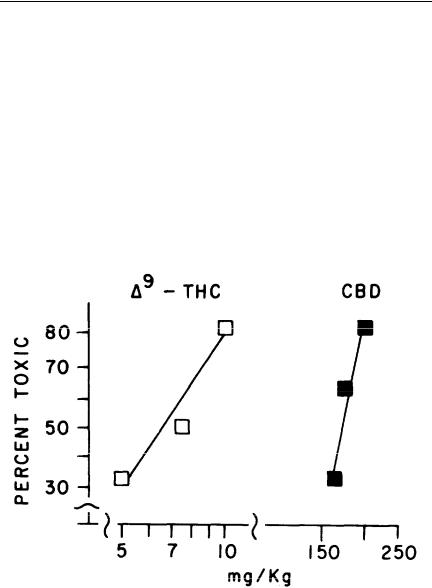
TABLE 2
Species Differences in Drug Potencies
in the Maximal Electroshock Test
|
|
|
AD50 (mg/kg)* |
|
Drug |
Mouse |
Rat |
Frog |
|
|
|
|
|
|
THC |
100 |
5 |
0.1 |
|
CBD |
120 |
50 |
0.1 |
|
Phenytoin |
9 |
5 |
10 |
|
Phenobarbital |
12 |
12 |
8 |
|
|
|
|
|
|
*Values calculated from dose-response data. From Karler and Turkanis 1981. Copyright 1981 by The American College of Clinical Pharmacology, Inc. (New York).
FIGURE 2. Dose-effect relationships for THC and CBD in a bar-walk test with rats. The TD50s and their 95% confidence limits (mg/kg, i.p.) are 6.6 (4.8-9.0) for THC and 173 (156-192) for CBD. The values were calculated by methods described by Litchjield and Wilcoxon (1949). Each point represents results jrom 6-8 male Sprague-Dawley rats weighing 250-280 gm. The relative potency for CBD compared to THC was 0.04 (Smiley et al. 1979).
100

The data in table 3 illustrate the comparative selectivity of the cannabinoids, as described conventionally in terms of the protective index, that is the ratio of the TD50 to the ED50. The point of the experiment was to examine the quantitative relationship between anticonvulsant activity and motor toxicity in order to determine if these two effects are separable. Motor toxicity is a major side effect of all antiepileptic drugs. In pharmacological terms, we were raising the issue here of the selectivity of these compounds as anticonvulsants relative to their general CNS depressant activity. Clinically, the usefulness of any drug, in part, depends upon its selectivity for a desired effect.
TABLE 3
Effects of a Single Dose of Cannabinoid in Mice
in a Maximal Electroshock and a Bar-walk Test
|
|
|
|
Protective |
|
Peak-effect |
ED50 |
TD50 |
Index |
Drug |
Time (hr)* |
(mg/kg) |
(mg/kg) |
(TD50/ED50) |
|
|
|
|
|
DMHP |
2 |
13 |
5 |
0.4 |
Delta-9-THC |
2 |
100 |
80 |
0.8 |
CBN |
1 |
230 |
230 |
1.0 |
CBD |
1 |
120 |
180 |
1.5 |
11-Hydroxy-THC |
1 |
14 |
22 |
1.6 |
Delta-8-THC |
2 |
83 |
152 |
1.8 |
|
|
|
|
|
All experiments were performed at an ambient temperature of approximately 22°C; ED50 and TD50 values were calculated by the method of Litchfield and Wilcoxon (1949) from conventional dose-response curves based on 3-6 doses with 15-20 animals for each dose; drugs were administered i.p.
*The peak-effect times for the anticonvulsant and toxic effects were similar.
From Karler and Turkanis 1976. Copyright 1976 by Plenum Publishing Corp. (New York).
In this table are listed the protective index data for DMHP, delta-9-THC, cannabinol (CBN), CBD, the 11-hydroxy metabolite, and delta-8-THC. For DMHP, the ED50 against the maximal electroshock is 11.5 mg/kg and the TD50 is 4.6 mg/kg, yielding a protective index of 0.4. Similarly, the protective index for delta-9-THC is 0.8; for CBN, 1.0; for CBD, 1.5; for 11-hydroxy-THC, 1.6; and for delta-8-THC, 1.8. For comparative purposes, the protective index for phenobarbital is 1.5 (Karler and Turkanis 1981). These data clearly illustrate that
101

the anticonvulsant and motor-toxic activities are at least partially separable, ranging from DMHP and THC, which are more motor toxic than anticonvulsant, to CBD, 11-hydroxy-THC, and delta-8-THC, which exhibit more anticonvulsant than toxic activity.
The data in table 4 represent a summary of the results obtained from five different convulsive threshold tests. All of the anticonvulsant data described above have been limited to only one convulsive test, that is, the MES test. There are, however, many such tests, and table 4 contains the comparative results of THC and CBD from a variety of electroand chemo-shock tests.
TABLE 4
Anticonvulsant Properties of the Cannabinoids
|
Convulsive |
THC |
CBD |
|
Threshold Test |
||
|
|
|
|
Minimal |
- |
+ |
|
|
60-Hz-EST |
||
|
6-HZ-EST |
+ |
+ |
|
Pentylenetetrazol |
- |
0 |
Maximal |
+ |
+ |
|
|
MEST |
||
|
Pentylenetetrazol |
+ |
+ |
|
|
|
|
+ = anticonvulsant activity; - = proconvulsant activity; 0 = no activity.
CBD is anticonvulsant in four of the five tests; THC, however, has a very different spectrum of activity because it is anticonvulsant in three tests, but is proconvulsant in the 60-Hz-EST and the pentylenetetrazol minimal threshold test. This was the first evidence that we had to indicate that THC exerts not only depressant effects but also excitatory effects. Subsequently, we have observed THC’s excitatory properties in many other experimental situations. For example, THC can precipitate frank convulsions in cobaltand iron-epileptic rats (Chiu et al. 1979; Turkanis and Karler 1982); THC enhances electrically induced limbic seizure activity in the rat (Smiley et al. 1979); and THC increases the rate of kindling to both electrical and chemical stimuli (Karler et al. 1984). In striking contrast, in all of these test situations, CBD displays only anticonvulsant or depressant properties. We have also observed THC excitatory effects at every level of organization of the nervous system, from the intact animal to the synapse (Turkanis and Karler 1981). In none of these tests has CBD shown any excitatory activity. On these grounds, we have concluded that the excitatory properties of the cannabinoids are completely separable from the depressant properties.
102
The data shown in figures 3 and 4 represent the influence of chronic THC or CBD treatment on their anticonvulsant properties. All of the anticonvulsant data described above were derived from acute experiments. In contrast, the data in figure 3 were obtained from animals treated for 22 days with a single daily dose of THC. The top of the figure shows the results from the 6-HZ-EST test. On day 1, THC raised this convulsive threshold about 20 V, which reflects its anticonvulsant activity in this test. During the course of the 22 days, tolerance developed because the anticonvulsant activity decreased. In the next test, the 60- Hz-EST, THC is proconvulsant because on day 1 it decreased seizure threshold by 2 mA, but again tolerance appeared to develop with repeated daily treatment. Finally, in the third test, the maximal EST, THC acutely is anticonvulsant because it elevated the threshold on day 1, but again tolerance developed to this effect. The two curves at the bottom of the figure illustrate that the tolerance in these instances is a true tolerance because there were no significant changes in either the brainor the plasma-THC concentrations with chronic treatment.
Figure 4 presents the results of chronic CBD treatment in the identical experimental paradigm as that used for the previous THC study. But the results are very different. In the two seizure-threshold tests shown at the top of the figure, that is, the 6-HZ- and 60-Hz-EST tests, the anticonvulsant activity of CBD progressively increased with chronic treatment, just the opposite response from the tolerance observed with THC.
An enhanced response to a given dose of drug administered chronically has been termed by some investigators as "reverse tolerance," and it is a phenomenon that has been repeatedly described for CNS locomotor stimulants, such as cocaine, amphetamine, and morphine (Post and Kopanda 1975; Segal and Mandell 1974; Shuster et al. 1975). This may be the first report of "reverse tolerance" developing to depressant effects, in this case, anticonvulsant effects. The instances of "reverse tolerance" again clearly distinguish CBD from THC. The results of the maximal EST indicate that tolerance develops to the other two effects. With respect to this test, CBD resembles THC because tolerance developed to both of the drugs.
Although antiepileptics are taken chronically, studies of chronic effects of these drugs are conspicuously absent from the literature. For this reason, we included phenytoin in our cannabinoid study and found that in one of the tests, tolerance developed; in another test, there was no change in pharmacodynamics; and in the third test, "reverse tolerance” developed (Karler et al. 1982). The "reverse tolerance" in this case is of special interest because it is clinically recognized that there exists a time lag of a few weeks before the antiepileptic activity of phenytoin completely manifests itself. Currently, there is no explanation for the time lag, but our animal data suggest that the lag may be due to the time required to develop "reverse tolerance." In any event, the phenomenon of "reverse tolerance" may add a new dimension to the study of antiepileptic drugs, as well as to the study of cannabinoids.
DISCUSSION
The data presented were selected to provide an overview of what we consider to be some of the more important pharmacological characteristics of the cannabinoids that have emerged from our whole-animal studies of their anticonvulsant properties. We have seen, for example, as have others, that the anticonvulsant activity is separable from the psychoactivity. Without such a separation, these drugs would have no clinical potential as antiepileptics. We also
103
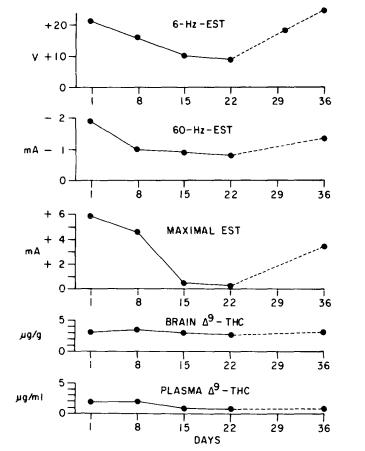
FIGURE 3. Influence of repeated THC treatment on ESTs. In each test, 60 mice were given 10 mg/kg THC i.p. once daily, and another 60 mice, vehicle. The points indicate the differences in EST between drugand vehicle-treated groups. —— = period of daily treatment: ----- = period oj withdrawal. Brain and plasma values represent data from 6-8 mice. On day 1 the vehicle-control values were 23 (21-24) V for the 6-Hz-EST, 5.9 (5.7-6.1) mA Jor the 60-Hz-EST and 7.5 (7.0-8.0) mA for the MEST and, as determined by a relative potency test of Litchfield and Wilcoxon (1949) (P < 0.05), were significantly different from the drug-treated groups. From Karler et al. 1982. Copyright 1982 by SpringerVerlag (Heidelberg).
104
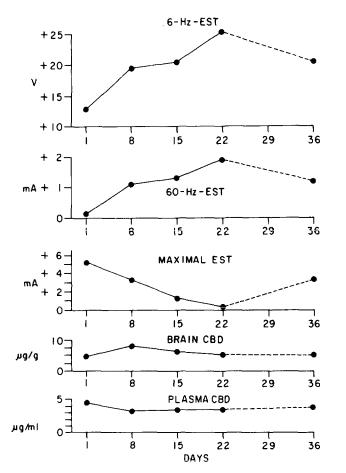
FIGURE 4. Influence of repeated CBD treatment on the ESTs and on brain and plasma-drug concentrations. On day 1 vehicle-control values were 21.5 (20-23) V for the 6-HZ-EST, 5.4 (5.1-5.8) mA for the 60-Hz-EST and 7.9 (7.6-8.3) mA for the MEST, and on day 1 only the 6-HZ-EST and MEST vehicle-control values were significantly different from those obtained from CBD-treated groups as determined by a relative potency test. See figure 3 for additional information. From Karler et al. 1982. Copyright 1982 by Springer-Verlag (Heidelberg).
observed that among the different cannabinoids, there are differences in potency, there are differences in the protective index, and there are species differences in response to them. None of these observations is too surprising because such differences are general characteristics of drugs. Detailed structure-activity studies would probably yield cannabinoids with more selectivity as anticonvulsants than those that we have studied. The "reverse tolerance" to CBD was a surprise. What this means vis-a-vis an antiepileptic drug is not clear, but the observation that a similar response to chronic phenytoin treatment raises the possibility that the clinical efficacy of phenytoin may, in part, be due to "reverse tolerance." Although "reverse tolerance" was not observed for THC in the
105
anticonvulsant study, the CBD data illustrate that "reverse tolerance" can occur to cannabinoid effects; therefore, the toxicological or pharmacological evaluation of any cannabinoid should involve the assessment of effects in chronically treated, as well as acutely treated, animals.
In the course of our studies, we have tried to emphasize that anticonvulsant activity is not a single entity; rather, it is a complex group of effects. That point is clearly seen in the case of THC which is anticonvulsant in some tests and proconvulsant in others. This resembles the clinical response generally to antiepileptic drugs. Phenytoin, for example, is effective in the treatment of grand mal epilepsy; however, it can exacerbate absence seizures. The reverse is true for ethosuximide. In animal studies, these drugs resemble THC because they all exhibit both anticonvulsant and proconvulsant properties. In retrospect, what is interesting about CBD as an anticonvulsant is that we have not yet seen any indication of an excitatory effect on CNS function. In this sense, it may be unique as an anticonvulsant. Despite a number of favorable properties of CBD, its future as an antiepileptic--at least in this country--is not very promising. Although the anticonvulsant drug-screening program sponsored by the National Institute of Neurological and Communicative Disorders and Stroke (NINCDS) screened CBD and found it to have anticonvulsant activity, it has not been recommended for clinical trial, and it is the NINCDS recommendation that determines which new antiepileptics will be clinically tested in this country. The drug industry in the past has been reluctant to develop new antiepileptics because the potential market is too small to justify the drug developmental expense.
Even now that the NINCDS is providing much of the developmental costs, what drug company would be willing to bear the marketing cost of a nonpatentable, marginally profitable drug such as CBD? It is for this reason that we are pessimistic about the future of CBD as an antiepileptic. It may remain just as we found it: a very interesting laboratory drug.
REFERENCES
Carlini E.A.; Mechoulam, R.; and Lander, N. Anticonvulsant activity of four oxygenated cannabidiol derivatives. Res Commun Chem Pathol Pharmacol 12:1-15, 1975.
Chiu, P.; Olsen, D.M.; Borys, H.K.; Karler, R.; and Turkanis, S.A. The influence of cannabidiol and delta-9-tetrahydrocannabinol on cobalt epilepsy in rats. Epilepsia 20:365-375, 1979.
Consroe, P.; Jones, B.; Laird, H., II; and Reinking, J. Anticonvulsant-convulsant effects of delta-9-tetrahydrocannabinol. In: Cohen, S., and Stillman, R.C., eds. The Therapeutic Potential of Marihuana. New York: Plenum Publishing Corp., 1976. pp. 343-362.
Davis, J.P., and Ramsey, H.H. Antiepileptic action of marihuana-active substances. Fed Proc 8:284-285, 1949.
Karler, R., and Turkanis, S.A. The antiepileptic potential of the cannabinoids. In: Cohen, S., and Stillman, R.C., eds. The Therapeutic Pontential of Marihuana. New York: Plenum Publishing Corp., 1976. pp. 383-397.
Karler, R., and Turkanis, S.A. The cannabinoids as potential antiepileptics. J Clin Pharmacol 21:437S-448S, 1981.
Karler, R.; Cely, W.; and Turkanis, S.A. The anticonvulsant activity of cannabidiol and cannabinol. Life Sci 13: 15271531, 1973.
Karler, R.; Cely, W.; and Turkanis, S.A. Anticonvulsant properties of delta-9- tetrahydrocannabinol and other cannabinoids. Life Sci 15:931-947, 1974.
106
Karler, R.; Borys, H.K.; and Turkanis, S.A. Influence of 22-day treatment on the anticonvulsant properties of cannabinoids. Naunym Schmiedebergs Arch Pharmacol 320:105-109, 1982.
Karler, R.; Calder, L.D.; and Turkanis, S.A. Changes in CNS sensitivity to cannabinoids with repeated treatment: Tolerance and auxoesthesia. In: Sharp, C., ed. Mechanisms of Tolerance and Dependence: 1984. National Institute on Drug Abuse Research Monograph 54. DHHS Pub. No. (ADM) 84-1330. Washington, D.C.: Supt. of Docs., U.S. Govt. Print. Off., 1984. pp. 212-222.
Lemberger, L.; McMahon, R.; Archer, R.; Matsumoto, K.; and Rowe, H. Pharmacologic effects and physiologic disposition of delta-6-alpha, 10-alpha- dimethylheptyltetrahydrocannabinol (DMHP) in man. Clin Pharmacol Ther 15:380-386, 1974.
Litchfield, J.T., Jr., and Wilcoxon, F.A. A simplified method of evaluating dose-effect experiments. J Pharmacol Exp Ther 95:99-113, 1949.
Loewe, S., and Goodman, L.S. Anticonvulsant action of marihuana-active substances. Fed Proc 6:352, 1947.
Post, R.M., and Kopanda, R.T. Cocaine, kindling and reverse tolerance. Lancet 1:409-410, 1975.
Segal, D.S., and Mandell, A.J. Long-term administration of d-amphetamine: Progressive augmentation of motor activity and stereotypy. Pharmacol Biochem Behav 2:249-255, 1974.
Shuster, L.; Webster, G.W.; and Yu, G. Increased running response to morphine in morphine-treated mice. J Pharmacol Exp Ther 192:64-72, 1975.
Smiley, K.A.; Turkanis, S.A.; Borys, H.K.; Olsen, D.M.; and Karler, R. An electrophysiological analysis of the anticonvulsant action of cannabidiol on limbic seizures in the conscious rat. Epilespsia 20:351-363, 1979.
Turkanis, |
S.A., and |
Karler, R. Electrophysiologic properties of the cannabinoids. |
J Clin |
Pharmacol |
21:449S-463S, 1981. |
Turkanis, S.A., and Karler, R. Central excitatory properties of delta-9- tetrahydrocannabinol and its metabolites in iron-induced epileptic rats. Neuropharmacology 21:7-13, 1982.
Turkanis, S.A.; Cely, W.; Olsen, D.M.; and Karler, R. Anticonvulsant properties of cannabidiol. Res Commun Chem Pathol Pharmacol 8:231-246, 1974.
ACKNOWLEDGMENT
This research was supported by research grant DA-00346 from the National Institute on Drug Abuse.
AUTHORS
Ralph Karler, Ph.D.
Stuart A. Turkanis, Ph.D.
Department of Pharmacology
University of Utah School of Medicine
Salt Lake City, Utah 84132
107
Pharmacological Evaluation of
Agonistic and Antagonistic Activity
of Cannabinoids
Billy R. Martin, Ph.D.; David R. Compton, Ph.D.; Patrick J. Little, B.S.; Thomas J. Martin, B.S.; and Patrick M. Beardsley, Ph.D.
INTRODUCTION
The currently proposed mechanisms by which the cannabinoids could be producing their central effects involve either general membrane perturbation or direct interaction with a specific cannabinoid receptor. The difficulty in defining the mechanism by which  -THC alters central function could be because the cannabinoid behavioral syndrome represents a composite of several independent effects, rather than a single event. Therefore, it is possible that both mechanisms play an important role in the total behavioral effect of the cannabinoids. The observed behavioral syndrome may be a composite of multiple independent effects, each of which could be a function of either a nonspecific cannabinoid action or, alternatively, of a specific cannabinoid effect which might be modified (at higher drug doses) by nonspecific interactions. It is our objective to determine whether either of these mechanisms is responsible for
-THC alters central function could be because the cannabinoid behavioral syndrome represents a composite of several independent effects, rather than a single event. Therefore, it is possible that both mechanisms play an important role in the total behavioral effect of the cannabinoids. The observed behavioral syndrome may be a composite of multiple independent effects, each of which could be a function of either a nonspecific cannabinoid action or, alternatively, of a specific cannabinoid effect which might be modified (at higher drug doses) by nonspecific interactions. It is our objective to determine whether either of these mechanisms is responsible for  -THC’s effects. If cannabinoids are interacting with specific binding sites, then there should be a strict structure-activity relationship (SAR) as well as a specific antagonist. Alternately, if the cannabinoids are producing their effects solely by perturbation of membranes, there should not be a specific antagonist, but there may be a correlation between activity and membrane (lipid) solubility as measured by partition coefficients. The partial development of a SAR for several cannabinoid behavioral effects has been established by evaluating the agonistic and antagonistic activity of newly synthesized analogs in a variety of behavioral test systems. These tests include spontaneous activity, rectal temperature and analgesia (mouse), blood pressure, heart rate, and respiratory rate (rat), static ataxia (dog), and conditioned operant behavior (monkey) (Martin et al. 1975, 1984a, 1984b; Beardsley et al., in press). Additionally, attempts have been made to distinguish those cannabinoid structural features associated with only a portion of the behavioral syndrome normally observed with THC as an effort to determine if a unique SAR exists for each behavioral measure, which would support the notion that the cannabinoid syndrome is composed of multiple behavioral effects (Martin 1986). We propose that the pharmacological properties unique to the cannabinoid class of drugs are produced by the interaction of
-THC’s effects. If cannabinoids are interacting with specific binding sites, then there should be a strict structure-activity relationship (SAR) as well as a specific antagonist. Alternately, if the cannabinoids are producing their effects solely by perturbation of membranes, there should not be a specific antagonist, but there may be a correlation between activity and membrane (lipid) solubility as measured by partition coefficients. The partial development of a SAR for several cannabinoid behavioral effects has been established by evaluating the agonistic and antagonistic activity of newly synthesized analogs in a variety of behavioral test systems. These tests include spontaneous activity, rectal temperature and analgesia (mouse), blood pressure, heart rate, and respiratory rate (rat), static ataxia (dog), and conditioned operant behavior (monkey) (Martin et al. 1975, 1984a, 1984b; Beardsley et al., in press). Additionally, attempts have been made to distinguish those cannabinoid structural features associated with only a portion of the behavioral syndrome normally observed with THC as an effort to determine if a unique SAR exists for each behavioral measure, which would support the notion that the cannabinoid syndrome is composed of multiple behavioral effects (Martin 1986). We propose that the pharmacological properties unique to the cannabinoid class of drugs are produced by the interaction of  -THC with specific receptors, while cannabinoid-induced central nervous system (CNS) depression is a general phenomenon produced by nonspecific membrane interactions.
-THC with specific receptors, while cannabinoid-induced central nervous system (CNS) depression is a general phenomenon produced by nonspecific membrane interactions.
108
METHODS
Cannabinoids
The analogs 1-24, 32, and 33 were synthesized by Dr. Raj Razdan and 25, 29, and 31 by Dr. Everette May. Compounds 26-28 were obtained from the National Institute on Drug Abuse and compound 30 was provided by the National Cancer Institute. The procedure of Olson et al. (1973) was used to prepare micellar suspensions of cannabinoids suitable for injection. The cannabinoids (10 mg) were dissolved in 100 µl of a 1:1 mixture of 95% ethanol and emulphor (a polyoxyethylated vegetable oil manufactured by GAF) by sonification. This solution was then diluted with ethanol:emulphor:saline (1:1:18) to provide the desired concentration, and injected intravenously (i.v.), unless stated otherwise.
Spontaneous Activity, Rectal Temperature, and Antinociceptive
Activity in Mice
Analogs are evaluated initially in these three tests in order to assess their general pharmacological activity. To conserve limited supplies of drugs, these measurements are recorded sequentially in the same animal as described previously (Martin et al. 1984a, 1984b; Jorapur et al. 1985). Male ICR mice (22-30 g) are housed in the laboratory for 24 hr before treatment. The ambient temperature of the laboratory, which varies from 22 to 24 °C from day to day, is recorded at the beginning and end of each experiment. Rectal temperature is determined by a thermistor probe (inserted 25 mm) and a telethermometer (Yellow Springs Instrument Co., Yellow Springs, OH) just prior to vehicle or drug administration. Following the initial temperature determinations, control tail-flick reaction times are determined for each animal as described below. The mice are then injected i.v. with either vehicle or drug (0.1 ml/10 g of body weight) and immediately placed in individual photocell activity chambers. After the animals have acclimated for 5 min, interruptions of the photocell beams are recorded for a 10-min session. The mice are removed from the activity chambers, and tail-flick response is determined 5 min later. Rectal temperature is measured 60 min after drug administration. The spontaneous activity of the treated animals is expressed as percent of control, and the ED50s(and confidence limits) are determined by the method of Litchfield and Wilcoxon (1949). The difference between rectal temperature before and 60 min after treatment is calculated for each mouse.
The antinociceptive activity procedure is essentially the same as that described by D'Amour and Smith (1941) and Dewey et al. (1970). A mouse's tail is placed on a notched block so as to occlude a slit over a photocell detector. Heat is applied by a 100-watt lamp mounted in a reflector. The apparatus is arranged so that when the operator turns on the lamp a timer is activated. When the mouse flicks its tail, the light falls on the photocell and automatically stops the timer. The intensity of the lamp is adjusted to give a normal reaction time between 2 and 4 sec. A control reaction time is taken for each animal prior to treatment. The mice then receive an i.v. injection of the drug and are tested at the appropriate time. A maximum 10-sec cut-off (latency) time is employed in order to prevent damage to the animal’s tail. The antinociceptive response is expressed as a percent of the maximum possible increase in latency. Percent response is calculated from the equation: % R = (T - Tc/10 - Tc) x 100 where T is the mean test reaction time, and Tc is the control reaction time. The ED50 (and confidence limits) are determined by the method of Litchfield and Wilcoxon (1949).
109

Static Ataxia in Dogs
The ability of cannabinoids to produce static ataxia (an effect unique to psychoactive cannabiioids) and other characteristic behavioral effects is examined in mongrel dogs of either sex (10-18 kg). On the test day, the animals are moved from their home cages to the observation room, and behavior is evaluated for 5 to 10 min prior to drug administration. The normal behavior of each animal (which includes spontaneous activity, gait, tail tuck, hyperreflexia, etc.) is recorded. Each animal is then injected i.v. with either the cannabiioid or the vehicle (1 ml/kg of body weight), and their behavior is rated at 5-min intervals according to the static ataxia scale as described previously (Walton et al. 1938; Martin et al. 1975) and as depicted in table 1. Typical test sessions consist of four animals that receive either vehicle, -THC (0.2 mg/kg which typically produces a rating of 3-4), or one of two other cannabinoid treatments. Only one of the experimenters is knowledgeable to the treatment. Behavior is scored by three observers who are "blind" with regard to treatment.
-THC (0.2 mg/kg which typically produces a rating of 3-4), or one of two other cannabinoid treatments. Only one of the experimenters is knowledgeable to the treatment. Behavior is scored by three observers who are "blind" with regard to treatment.
TABLE 1
Quantitation of the Behavioral Effects Produced by Cannabinoids in Dogs
Score |
Behavioral Effects |
|
|
0 |
No effect |
1 |
Slight depression of activity, slight static ataxia seen only after |
|
the dog has been standing in one position for 3 to 5 min. |
2Walks with a prance-like placement of feet, exaggerated reflex to a swinging hand, and static ataxia after standing in one position for 2 to 3 min.
3Tail is often tucked, some loss of tone in hind legs as evidenced by a semisquatting position, static ataxia more pronounced and seen after dog stands in one position for 1 to 2 min, and nodding may be observed 30 to 60 min after injection.
4 |
Marked |
static ataxia, sways forward and backward and/or side |
|
to side, |
and almost falls after standing in one position for 1 |
|
min. |
|
5Cannot stand for longer than 30 sec without almost falling and often plunges about.
6Lies prostrate on the floor.
110
Conditioned Operant Responding in Monkeys
Rhesus monkeys are trained on a multiple timeout 3-min fixed-ratio x schedule to lever press for food pellets as described by Beardsley et al. (in press). During drug testing, the animals receive cumulative dosing of cannabinoids, as described in table 5, and the dose at which the behavioral sign appears is recorded. The vehicle did not produce any of the indicated behavioral signs nor did it suppress conditioned responding.
Protocol for Determining Antagonistic Activity
Analogs with little or no agonistic activity in these tests are evaluated for antagonistic activity. Antagonism in spontaneous activity and rectal temperature measures is studied in one group of mice, whereas antinociceptive activity is evaluated in a separate group of animals. A subthreshold dose of the analog (or vehicle) is administered i.v. 10 min prior to an i.v. administration of  -THC (ED50 dose for producing hypoactivity) or vehicle. Spontaneous activity and rectal temperature are measured (described above) in the following treatment groups: analog plus
-THC (ED50 dose for producing hypoactivity) or vehicle. Spontaneous activity and rectal temperature are measured (described above) in the following treatment groups: analog plus  -THC (A), analog (B),
-THC (A), analog (B),  -THC (C), and vehicle (D). Antagonism of hypothermia is calculated from the following equation:
-THC (C), and vehicle (D). Antagonism of hypothermia is calculated from the following equation:
%AD h y p o t h e r m.i a = {1 - [(A -B) ÷ (C -D)]} x 100 where A through D represent the
differences between preinjection and postinjection (60 min) rectal temperatures. The antagonism of hypoactivity is calculated from the following equation:
%ADhypoactivity = {1-[1-(A ÷ B)] ÷ [1- (C ÷D)]) x 100 where A through D represent the spontaneous activity (counts per 10-min period). To measure antagonism in the tail-flick procedure, the analog is administered i.v. 10 min prior to an i.v. dose of  -THC (ED80 dose for producing antinociception). The mice are tested 5 min after the second injection. Two injections of vehicle into the tail vein have no effect on the tail-flick response. The results are expressed as percent antagonism of the THC antinociceptive effect. The AD50 values (and confidence limits) are determined by the probit analysis method of Litchfield and Wilcoxon (1949).
-THC (ED80 dose for producing antinociception). The mice are tested 5 min after the second injection. Two injections of vehicle into the tail vein have no effect on the tail-flick response. The results are expressed as percent antagonism of the THC antinociceptive effect. The AD50 values (and confidence limits) are determined by the probit analysis method of Litchfield and Wilcoxon (1949).
Antagonistic activity of analogs is evaluated in dogs by pretreating i.v., with either vehicle or analog, 10 min prior to the i.v. administration of either vehicle or  -THC (0.2 mg/kg). In this way, each test session consists of the following treatments: vehicle, analog,
-THC (0.2 mg/kg). In this way, each test session consists of the following treatments: vehicle, analog,  -THC, and analog +
-THC, and analog +  -THC. Behavioral activity is evaluated for 60 min after the
-THC. Behavioral activity is evaluated for 60 min after the  -THC injection. The maximum effect of
-THC injection. The maximum effect of  -THC is usually observed between 15 and 30 min after administration. Analogs are evaluated at the highest possible dose in duplicate or triplicate. Analogs with antagonistic activity are evaluated at two other doses (in duplicate) so that AD50 values can be calculated. Dogs are retested at weekly intervals, but never more than four times total. Development of tolerance has not been observed when low doses of cannabinoids are given as infrequently as once a week.
-THC is usually observed between 15 and 30 min after administration. Analogs are evaluated at the highest possible dose in duplicate or triplicate. Analogs with antagonistic activity are evaluated at two other doses (in duplicate) so that AD50 values can be calculated. Dogs are retested at weekly intervals, but never more than four times total. Development of tolerance has not been observed when low doses of cannabinoids are given as infrequently as once a week.
RESULTS
Antinociceptive Studies
Cannabinoids have previously been considered to be weak antinociceptive agents (Buxbaum 1972; Dewey et al. 1972; Chesher et al. 1973; Sofia et al. 1973; Noyes et al. 1975; Wilson et al. 1976; Bloom et al. 1977; Gilbert 1981; Sofia and Barry
111
1983). However, i.v. administration of  -THC demonstrates that it has antinociceptive properties comparable to those of morphine sulfate (Martin 1985a). SAR studies demonstrate that the structural requirements for cannabinoid-induced antinociceptive activity, as measured in the tail-flick procedure, are quite similar to those necessary for inducing hypoactivity and hypothermia (Martin 1985b). These findings, coupled with the observation that i.v. administration of
-THC demonstrates that it has antinociceptive properties comparable to those of morphine sulfate (Martin 1985a). SAR studies demonstrate that the structural requirements for cannabinoid-induced antinociceptive activity, as measured in the tail-flick procedure, are quite similar to those necessary for inducing hypoactivity and hypothermia (Martin 1985b). These findings, coupled with the observation that i.v. administration of  -THC (ED50 = 1.9 mg/kg) results in consistent and potent antinociceptive activity, suggest that the tail-flick procedure is a reasonable test for assessing agonistic and antagonistic activity of cannabinoids.
-THC (ED50 = 1.9 mg/kg) results in consistent and potent antinociceptive activity, suggest that the tail-flick procedure is a reasonable test for assessing agonistic and antagonistic activity of cannabinoids.
Evaluation of Agonistic Activity of CBD Analogs
The behavioral profiles and structures of CBD analogs evaluated for pharmacological activity in mice are presented in table 2. Interest in these 10-N-substituted analogs is derived from early suggestions that CBD itself exhibited some antagonistic properties (see Martin 1986 for a recent review). The ethylamino (1) and propylamino (2) analogs are as potent as  -THC in decreasing spontaneous activity and rectal temperature, but exhibit only slight antinociceptive activity (Jorapur et al. 1985). Additionally, 1 lacks specific cannabinoid effects in the dog static-ataxia test, although it does produce CNS depresson at i.v. doses of 1 to 2 mg/kg. An interesting aspect of these two analogs' activity profile is their high toxicity (LD50 = 5 mg/kg), whereas the LD50 of CBD is >100 mg/kg. However, other lo-substituted CBD analogs (3-10 ) have been prepared, and they are relatively inactive in all mouse tests. The N-methyl- N-propargyl (7 ) and morpholino (10) CBD analogs are diacetyl derivatives which are weakly active (
-THC in decreasing spontaneous activity and rectal temperature, but exhibit only slight antinociceptive activity (Jorapur et al. 1985). Additionally, 1 lacks specific cannabinoid effects in the dog static-ataxia test, although it does produce CNS depresson at i.v. doses of 1 to 2 mg/kg. An interesting aspect of these two analogs' activity profile is their high toxicity (LD50 = 5 mg/kg), whereas the LD50 of CBD is >100 mg/kg. However, other lo-substituted CBD analogs (3-10 ) have been prepared, and they are relatively inactive in all mouse tests. The N-methyl- N-propargyl (7 ) and morpholino (10) CBD analogs are diacetyl derivatives which are weakly active ( 
 -THC) in producing hypoactivity, but inactive in the other two tests. Due to concerns regarding the penetrability of N-mustards into the CNS, analog 3 was also evaluated following intraventricular (i.v.t.) administration, and doses up to 150 µg/mouse (
-THC) in producing hypoactivity, but inactive in the other two tests. Due to concerns regarding the penetrability of N-mustards into the CNS, analog 3 was also evaluated following intraventricular (i.v.t.) administration, and doses up to 150 µg/mouse ( 5 mg/kg) do not alter spontaneous activity or tail-flick latency in mice, but they do produce a 3.8 °C drop in rectal temperature. An identical i.v.t. dose of
5 mg/kg) do not alter spontaneous activity or tail-flick latency in mice, but they do produce a 3.8 °C drop in rectal temperature. An identical i.v.t. dose of  -THC produces a 5.5 °C decrease in temperature, as well as a 68% decrease in spontaneous activity and a 55% increase latency in the tail-flick response. Only the ethylamino analog 1 has been evaluated in the dog static-ataxia test, and it failed to produce the classical cannabinoid syndrome. However, it did produce CNS depression at i.v. doses of 1 to 2 mg/kg, which was consistent with its effects in mice. Therefore, it appears that this analog may be prototypic of a cannabinoid with potent CNS depressant properties, but without antinociceptive or static-ataxia properties. The lack of agonistic properties in the other CBD analogs make them suitable for testing as antagonists.
-THC produces a 5.5 °C decrease in temperature, as well as a 68% decrease in spontaneous activity and a 55% increase latency in the tail-flick response. Only the ethylamino analog 1 has been evaluated in the dog static-ataxia test, and it failed to produce the classical cannabinoid syndrome. However, it did produce CNS depression at i.v. doses of 1 to 2 mg/kg, which was consistent with its effects in mice. Therefore, it appears that this analog may be prototypic of a cannabinoid with potent CNS depressant properties, but without antinociceptive or static-ataxia properties. The lack of agonistic properties in the other CBD analogs make them suitable for testing as antagonists.
Evaluation of Agonistic Activity of  -THC Analogs
-THC Analogs
The importance of the C-11 position has been well documented. The general consensus is that hydroxylation at this position increases biological activity, whereas removal of the C-11 position decreases potency (Martin et al. 1975). Numerous substitutions have been made at C-11 of  -THC (11-21) and the results are summarized in table 3. Alkylamino (11-14) or thioacetyl (16) substitutions have more or less resulted in loss of agonistic activity in the mouse tests with the exception of the N-methyl analog (11) which was as potent as
-THC (11-21) and the results are summarized in table 3. Alkylamino (11-14) or thioacetyl (16) substitutions have more or less resulted in loss of agonistic activity in the mouse tests with the exception of the N-methyl analog (11) which was as potent as  -THC in depressing spontaneous activity. The N-mustard (13, acetate of 14) was administered i.v.t. as described for analog 3 and found to be inactive up to doses of 150 µg/mouse. The alkyl analogs (17-21) are primarily additions of a bulky substituent at C-11 which dramatically attenuate behavioral activity.
-THC in depressing spontaneous activity. The N-mustard (13, acetate of 14) was administered i.v.t. as described for analog 3 and found to be inactive up to doses of 150 µg/mouse. The alkyl analogs (17-21) are primarily additions of a bulky substituent at C-11 which dramatically attenuate behavioral activity.
112
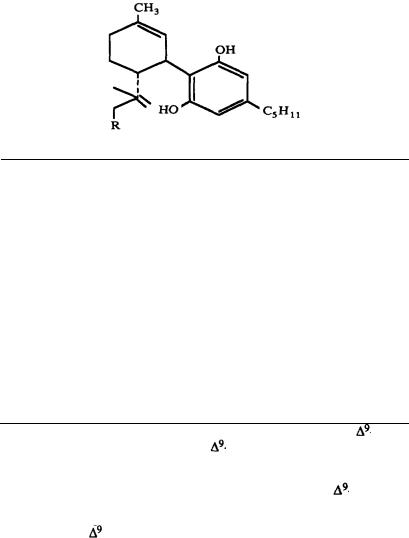
TABLE 2
Phamacological Activity of CBD and Structurally Related Analogs in Micea
|
|
|
|
S.A. b |
Pharmacological Profile |
|
|
R |
|
|
R.T. c |
T.F. d |
|
|
|
|
|
|
|
|
|
CBD |
|
|
0.08 |
0.03 |
<0.03 |
1 |
-NHC2H5 |
|
1.15 |
0.44 |
~0.30 |
|
2 |
-NHC3H7·HCl |
|
1.10 |
1.00 |
~0.40 |
|
3 |
-N(CH2CH2Cl)2 |
|
N.T.e |
N.T. |
N.T. |
|
4 |
-N3 |
<0.20 |
<0.05 |
<0.20 |
||
5 |
-SH |
<0.02 |
0.05 |
<0.20 |
||
6 |
-Br f |
< 0.08 |
0.15 |
<0.20 |
||
7 |
-N(CH3)CH2C=CHf |
|
0.25 |
0.03 |
<0.06 |
|
8 |
-N[CH(CH3)2]2f |
<0.05 |
0.03 |
<0.06 |
||
9 |
-NHCO(CH2)3NH2 |
|
0.08 |
0.11 |
<0.08 |
|
10 |
-cN(CH2CH2)2Of |
|
0.2 |
0.02 |
<0.06 |
|
a Pharmacological potency of i.v. analogs relative to that of i.v. |
-THC. |
|||||
b Spontaneous activity — the ED |
50 |
of |
-THC (2.3 mg/kg) was divided by |
|||
that of the analog. Less than (<) indicates the analog did not produce a 50% effect at the highest dose tested. Therefore, the ED50 was divided by the
highest dose tested. cRectal temperature — the dose of |
-THC |
(3.0 |
||
mg/kg) that produced a 1.6 °C decrease in rectal temperature |
divided |
by |
the |
|
dose of the analog that produced a comparable effect. d Tail-flick |
response |
|||
— the ED50 of |
-THC (1.9 mg/kg) was divided by that of the analog. |
|||
Less than (<) indicates the analog did not produce a 50% effect at the highest dose tested. e Not tested. fDiacetyl derivatives previously reported (Jorapur et al. 1985).
113

TABLE 3
Pharmacological Activity of  -THC and Structurally Related Analogs in Micea
-THC and Structurally Related Analogs in Micea
|
R b |
Pharmacological |
Profile |
||
|
S.A. |
R.T. |
T.F. |
||
|
|
|
|
|
|
|
-THC |
0.23 |
0.98 |
0.28 |
|
|
R l |
|
|
|
|
11 |
-CH2 NHCH3 c |
0.21 |
0.04 |
N.T. |
|
12 |
-CH2NHCH2CH3 |
<0.20 |
< 0.05 |
~ 0.20 |
|
13 |
-CH2N(CH2CH2Cl)2 acetate |
<0.20 |
0.08 |
< 0.20 |
|
14 |
-CH2N(CH2CH2Cl)2 |
< 0.07 |
0.03 |
0.06 |
|
15 |
-SH |
N.T. |
N.T |
N.T |
|
16 |
-SCOCH3 |
< 0.20 |
0.06 |
< 0.20 |
|
17 |
-C6 H5 c |
0.03 |
0.08 |
N.T. |
|
18 |
-CH2 C6 H5 c |
0.07 |
0.04 |
" |
|
19 |
-CH(CH3,)2c |
0.09 |
0.02 |
" |
|
20 |
-CH2CH2CH2CH3C |
0.07 |
0.27 |
" |
|
21 |
-CH(OH)CH2CH3c |
0.06 |
0.03 |
" |
|
22 |
R2 |
0.82 |
0.94 |
< 0.30 |
|
-NH2 |
|||||
23 |
0.92 |
0.82 |
< 0.60 |
||
-NHCH2CH3 |
|||||
24 |
-SCOCH3 |
<0.20 |
0.06 |
< 0.20 |
|
|
R3 and/or Side Chain |
|
|
|
|
25 |
-O2C(CH2)3N(CH2CH2)2O |
0.22 |
0.34 |
0.11 |
|
26 |
-O- |
1.1 |
1.13 |
N.T. |
|
|
Side chain = -(CH2)5N+(CH3)3 |
|
|
" |
|
27 |
Side chain = -(CH2)5Br |
1.1 |
2.44 |
||
" |
|||||
28 |
Side chain = -(CH2)5OAc |
0.79 |
~1.0 |
||
|
|||||
aPotency of analogs relative to -THC as described in legend of table 2.
-THC as described in legend of table 2.
bR1 and R2 = -CH3, R3 = -OH unless indicated. c Martin et al. 1984a.
114
Substitutions have also been made at position 12 of -THC, which is comparable to position 10 of CBD. Both 12ß-amino-
-THC, which is comparable to position 10 of CBD. Both 12ß-amino-  -THC (2 2) and the corresponding ethylamino derivative (23) effectively reduce spontaneous activity and rectal temperature as potently as
-THC (2 2) and the corresponding ethylamino derivative (23) effectively reduce spontaneous activity and rectal temperature as potently as  -THC, but have little or no effect on tail-flick response. In contrast, introduction of a thioacetyl group ( 24 ) reduces activity compared to
-THC, but have little or no effect on tail-flick response. In contrast, introduction of a thioacetyl group ( 24 ) reduces activity compared to -THC. Analogs 22 and 23 were similar to the CBD analogs 1 and 2 in that they too were quite toxic (lethal at 6-10 mg/kg). The pharmacological effects of 1-morpholinobutyryl -
-THC. Analogs 22 and 23 were similar to the CBD analogs 1 and 2 in that they too were quite toxic (lethal at 6-10 mg/kg). The pharmacological effects of 1-morpholinobutyryl -  -THC (MB-
-THC (MB- -THC, 25) were compared to the values obtained for
-THC, 25) were compared to the values obtained for  -THC tested during the same session, and the data suggest MB-
-THC tested during the same session, and the data suggest MB-  -THC is somewhat less potent (0.3-0.1) than
-THC is somewhat less potent (0.3-0.1) than  -THC. The values obtained with
-THC. The values obtained with  -THC were similar to those previously reported, and the potency range for the effects of MB-
-THC were similar to those previously reported, and the potency range for the effects of MB-  -THC is similar to that obtained for
-THC is similar to that obtained for  -THC relative to
-THC relative to  -THC (Martin et al. 1984a). These data would seem to support the notion that MB-
-THC (Martin et al. 1984a). These data would seem to support the notion that MB- -THC is metabolized rapidly by liver enzymes in vivo to
-THC is metabolized rapidly by liver enzymes in vivo to  -THC, which is probably responsible for the observed behavioral effects (Zitko et al. 1972).
-THC, which is probably responsible for the observed behavioral effects (Zitko et al. 1972).
The possibility that  -THC exerts some of its effects by interacting with a specific receptor has recently gained partial support from the studies of Nye et al. (1985) who defined a stereoselective, saturable, high affinity site for tritiated 5'-trimethylammonium-
-THC exerts some of its effects by interacting with a specific receptor has recently gained partial support from the studies of Nye et al. (1985) who defined a stereoselective, saturable, high affinity site for tritiated 5'-trimethylammonium-  -THC phenolate (5'-TMA, 26) binding. Therefore, in order to determine the relevance of this binding site to the behavioral effects of the cannabinoids, 5'-TMA has been evaluated and compared to
-THC phenolate (5'-TMA, 26) binding. Therefore, in order to determine the relevance of this binding site to the behavioral effects of the cannabinoids, 5'-TMA has been evaluated and compared to  -THC in our cannabinoid assays. Pharmacological comparison reveals that both
-THC in our cannabinoid assays. Pharmacological comparison reveals that both  -THC and 5'-TMA induce hypothermia (2.6° and 3.0°, respectively) at 5 mg/kg, and decrease spontaneous activity (ED50 = 10 mg/kg and 2.1 mg/kg, respectively) in the mouse after i.v. administration.
-THC and 5'-TMA induce hypothermia (2.6° and 3.0°, respectively) at 5 mg/kg, and decrease spontaneous activity (ED50 = 10 mg/kg and 2.1 mg/kg, respectively) in the mouse after i.v. administration.  -THC and 5'-TMA also induce hypothermia (4.4° and 5.0°, respectively at 100 µg), as well as hypoactivity (ED50 = 46 µg and 133 µg, respectively) after i.v.t. administration in the mouse. In the do both drugs, as well as
-THC and 5'-TMA also induce hypothermia (4.4° and 5.0°, respectively at 100 µg), as well as hypoactivity (ED50 = 46 µg and 133 µg, respectively) after i.v.t. administration in the mouse. In the do both drugs, as well as  -THC, produce mild sedation. However, only
-THC, produce mild sedation. However, only - and
- and  -THC produce static ataxia (at 0.4 mg/kg and 0.2 mg/kg i.v., respectively), while 5'-TMA is inactive at doses up to 1.0 mg/kg (i.v.). Although 5'-TMA exhibits CNS depressant properties, it appears to lack the specific behavioral effects that are typically produced by psychoactive cannabiioids.
-THC produce static ataxia (at 0.4 mg/kg and 0.2 mg/kg i.v., respectively), while 5'-TMA is inactive at doses up to 1.0 mg/kg (i.v.). Although 5'-TMA exhibits CNS depressant properties, it appears to lack the specific behavioral effects that are typically produced by psychoactive cannabiioids.
The 5'-bromo- (27) and 5'-acetyl- (28)  -THC analogs are similar in potency to to both 5'-TMA and
-THC analogs are similar in potency to to both 5'-TMA and  -THC in producing hypoactivity. However, 27 is more potent in decreasing rectal temperature (2.8 °C at 1 mg/kg). Analog 28 does produce hypothermia (maximum effect of 2.8 °C at 30 mg/kg), but not in a dose-related fashion (a 1.5 °C drop at doses of 1,3, and 10 mg/kg).
-THC in producing hypoactivity. However, 27 is more potent in decreasing rectal temperature (2.8 °C at 1 mg/kg). Analog 28 does produce hypothermia (maximum effect of 2.8 °C at 30 mg/kg), but not in a dose-related fashion (a 1.5 °C drop at doses of 1,3, and 10 mg/kg).
Evaluation of Agonistic Activity of  -THC Analogs
-THC Analogs
The behavioral data demonstrate that 1-O-succinyl-  -THC (29) possesses a pharmacological profile similar to that of
-THC (29) possesses a pharmacological profile similar to that of -THC. However, the analog is less potent than
-THC. However, the analog is less potent than  -THC in depressing spontaneous activity and in producing hypothermia and antinociception. While 29 appears to retain cannabinoid activity, one cannot rule out the possibility that the pharmacological activity is due to in vivo hydrolysis to
-THC in depressing spontaneous activity and in producing hypothermia and antinociception. While 29 appears to retain cannabinoid activity, one cannot rule out the possibility that the pharmacological activity is due to in vivo hydrolysis to  -THC. These data support the contention that substitutions at the phenolic hydroxyl of
-THC. These data support the contention that substitutions at the phenolic hydroxyl of  -THC reduce pharmacological activity.
-THC reduce pharmacological activity.
115
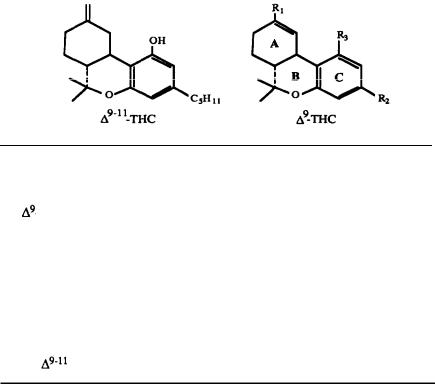
Alkylating agents of  - and
- and  -THC have been prepared for the purpose of acting
-THC have been prepared for the purpose of acting
as receptor probes. The N-mustard  -THC-1-bis(2-chloroethyl)carbamate (30 ) was found to be inactive if administered intraperitoneally (i.p.) or orally (p.o.), which suggests that this ester is not rapidly hydrolyzed in vivo to
-THC-1-bis(2-chloroethyl)carbamate (30 ) was found to be inactive if administered intraperitoneally (i.p.) or orally (p.o.), which suggests that this ester is not rapidly hydrolyzed in vivo to  -THC. However, 30 is active after either i.v. or i.v.t. administration. Following i.v. administration (table 4), 30 is at most only 0.06 times as potent as
-THC. However, 30 is active after either i.v. or i.v.t. administration. Following i.v. administration (table 4), 30 is at most only 0.06 times as potent as  -THC. In contrast, i.v.t. administration of the 30 produces effects on rectal temperature equivalent to that of
-THC. In contrast, i.v.t. administration of the 30 produces effects on rectal temperature equivalent to that of  -THC and is 0.2 times as potent as
-THC and is 0.2 times as potent as  -THC in producing hypoactivity (the tail-flick latency was not tested). These data suggest that the ability of 30, and possibly other N-mustards, to enter the CNS may be limited.
-THC in producing hypoactivity (the tail-flick latency was not tested). These data suggest that the ability of 30, and possibly other N-mustards, to enter the CNS may be limited.
TABLE 4
Pharmacological Activity of  -THC and Structurally Related Analogs in Micea
-THC and Structurally Related Analogs in Micea
|
|
|
|
|
|
|
|
Pharmacological |
Profile |
|
Rb |
|
|
|
|
S.A. |
R.T. |
T.F. |
|
|
|
|
|
|
|
|
|
||
|
-THCc |
|
|
|
1.00 |
1.00 |
1.00 |
||
29 |
R3 |
= |
succinyl |
|
0.15 |
0.30 |
0.34 |
||
30 |
R3 = -02CN(CH2CH2Cl)2 |
0.06 |
0.01 |
<0.01 |
|||||
31 |
R2 = -(CH2)5Br |
1.21 |
2.80 |
19.0 |
|||||
32 |
R |
2 |
= |
-(CH |
) |
CHOH-C H |
d |
|
|
|
|
|
2 |
2 |
2 |
3 |
|
|
|
|
S-3'-OH |
|
|
6.20 |
1.00 |
N.T. |
|||
|
R-3'-OH |
|
|
0.90 |
0.92 |
N.T. |
|||
33 |
R/S-3'-OH |
|
|
2.50 |
0.89 |
N.T. |
|||
|
|
|
-THC |
|
|
0.28 |
0.07 |
0.09 |
|
a Potency of i.v. analogs relative to i.v.  -THC on the spontaneous activity (S.A.), rectal temperature (R.T.), and tail-flick (T.F.) response
-THC on the spontaneous activity (S.A.), rectal temperature (R.T.), and tail-flick (T.F.) response
measures; calculated as described in the legend of table 2. b R1 = -CH3, R2
=-C5H11, and R3 = -OH unless indicated otherwise. c The ED50 is 2.3 and
1.9mg/kg for S.A and T.F., respectively, and a 1.6 °C drop occurs at 3 mg/kg. d Based on previously reported values (Martin et al. 1984a).
116

The 5'-bromo- |
-THC analog (31) is similar to the |
5'-bromo- |
-THC analog |
||
(27) in potency and profile. Analog 31 (table 4) is |
equipotent |
to |
-THC in |
||
reducing spontaneous activity and is roughly 3-fold |
more |
otent |
in |
producing |
|
hypothermia. Interestingly, 31 is 19-fold more potent than |
-THC in the mouse |
||||
antinociception |
test. Tests are currently under way |
to determine if |
27 , the |
||
5'-bromo- -THC analog, also shares this characteristic. |
|
|
|
||
Introduction of a hydroxyl group at the 3' position of the side chain (32 ) results in an R/S 3'-OH racemic mixture that retains cannabinoid-like activity (Martin et al. 1984a). Final resolution of each of the compounds results in a S-3'-OH mixture contaminated by 9% of the R isomer, and in an R-3'-OH mixture contaminated by 15% of the S isomer. Therefore, it is possible that the pharmacological effects observed by one of the "pure" isomers is partially (or totally) due to the opposite isomer. However, the pharmacological profiles of the racemate and each of the isomers suggest that the S isomer is 6-fold more potent at reducing spontaneous activity than  -THC. The R isomer also produces hypoactivity, but the result could be because 15% of the administered compound is actually the S isomer. In contrast, the ability of both the R and the S isomer, as well as the racemate, to produce hypothermia is nearly identical, and in fact is equipotent with
-THC. The R isomer also produces hypoactivity, but the result could be because 15% of the administered compound is actually the S isomer. In contrast, the ability of both the R and the S isomer, as well as the racemate, to produce hypothermia is nearly identical, and in fact is equipotent with  -THC. These data suggest that there is a specific side chain stereospecificity required for one effect (hypoactivity) that is not required for another (hypothermia). In fact, it is possible that the S, but not the R, isomer produces hypoactivity, while both isomers are equipotent in producing hypothermia.
-THC. These data suggest that there is a specific side chain stereospecificity required for one effect (hypoactivity) that is not required for another (hypothermia). In fact, it is possible that the S, but not the R, isomer produces hypoactivity, while both isomers are equipotent in producing hypothermia.
Evaluation of Cannabinoids for Antagonistic Properties
Since 10-N-ethylamino-CBD (1 ) is a partial antagonist of  -THC-induced antinociception (Jorapur et al. 1985), this compound has been tested further for antagonistic activity. Although 1 lacks specific cannabinoid effects in the dog static-ataxia test, pretreatment with 0.5 mg/kg (i.v.) of 1 does not alter the behavioral effects of
-THC-induced antinociception (Jorapur et al. 1985), this compound has been tested further for antagonistic activity. Although 1 lacks specific cannabinoid effects in the dog static-ataxia test, pretreatment with 0.5 mg/kg (i.v.) of 1 does not alter the behavioral effects of  -THC in dogs. Compound 1 also does not produce an antagonism of
-THC in dogs. Compound 1 also does not produce an antagonism of  -THC's effects on spontaneous activity and rectal temperature. Therefore, the attenuation of
-THC's effects on spontaneous activity and rectal temperature. Therefore, the attenuation of  -THC's effects by 1 appears to be limited to mouse antinociception. Additionally, 2 also produces a partial antagonism (38% at 3 mg/kg) of
-THC's effects by 1 appears to be limited to mouse antinociception. Additionally, 2 also produces a partial antagonism (38% at 3 mg/kg) of  -THC-induced antinociception, similar to 1. However, compound 2 also does not block
-THC-induced antinociception, similar to 1. However, compound 2 also does not block  -THC’s effects on spontaneous activity and rectal temperature, and therefore is not being tested further. The evaluation of the 10-bromo-CBD diacetate analog (6 ) for antagonistic activity indicates no alteration of
-THC’s effects on spontaneous activity and rectal temperature, and therefore is not being tested further. The evaluation of the 10-bromo-CBD diacetate analog (6 ) for antagonistic activity indicates no alteration of  -THC-induced antinociception at doses up to 30 mg/kg.
-THC-induced antinociception at doses up to 30 mg/kg.
The 12ß-amino-  -THC analog (22) does not alter
-THC analog (22) does not alter  -THC-induced hypoactivity and hypothermia as expected due to its agonistic activity. However, 22 does produce a slight attenuation in
-THC-induced hypoactivity and hypothermia as expected due to its agonistic activity. However, 22 does produce a slight attenuation in  -THC's antinociceptive activity. Doses of 22 of 0.3 to 3.0 mg/kg antagonized
-THC's antinociceptive activity. Doses of 22 of 0.3 to 3.0 mg/kg antagonized  -THC’s effects by 25%.
-THC’s effects by 25%.
Assessment of the antagonistic activity of the N-mustard  -THC-1-bis (2-chloroethyl) carbamate (30 ) following i.v. administration reveals that this compound is not an antagonist. High doses of 30 (100 mg/kg) attenuate the effects of
-THC-1-bis (2-chloroethyl) carbamate (30 ) following i.v. administration reveals that this compound is not an antagonist. High doses of 30 (100 mg/kg) attenuate the effects of  -THC administered 24 hr later, but this blockade appears to be due to desensitization, rather than antagonism, since
-THC administered 24 hr later, but this blockade appears to be due to desensitization, rather than antagonism, since  -THC itself produces a similar effect. However, it is possible that lower doses of 30, or a different experimental protocol, might reveal antagonistic properties.
-THC itself produces a similar effect. However, it is possible that lower doses of 30, or a different experimental protocol, might reveal antagonistic properties.
117

TABLE 5
 - and
- and  -THC's Effects on Conditioned Operant Responding in Monkeys
-THC's Effects on Conditioned Operant Responding in Monkeys
|
|
|
Cumulative |
Dose (mg/kg)a |
|
|
|
|
|
Operant |
Suppression |
|
|
T e s t |
Monkey |
Ptosis |
Ataxia |
Sedation |
|
|
Vehb |
639 |
|
|
|
|
|
|
M661 |
|
|
|
|
|
|
M572 |
|
|
|
|
|
|
824 |
|
|
|
|
|
-THcd |
639 |
0.250 |
0.25 |
0.50 |
0.050 |
|
|
M661 |
0.125 |
0.50 |
1.00 |
0.250 |
|
|
M572 |
0.125 |
0.50 |
1.00 |
0.125 |
|
|
824 |
0.250 |
1.00 |
0.25 |
0.005 |
|
-THCe |
639 |
|
|
|
1.000 |
|
|
M661 |
|
|
|
|
|
-THCf |
639 |
|
|
|
1.000 |
|
|
M661 |
|
|
|
|
|
|
M572 |
|
|
|
0.500 |
|
|
824 |
|
|
|
|
|
I N T g |
639 |
|
|
1.50 |
0.500 |
|
|
M661 |
|
1.00 |
1.50 |
|
|
|
M575 |
|
|
1.00 |
0.250 |
|
|
824 |
|
|
1.00 |
0.125 |
|
-THC d |
639 |
0.25 |
1.00 |
0.25 |
0.125 |
|
|
M661 |
0.25 |
1.00 |
0.50 |
0.500 |
|
|
M572 |
0.25 |
1.00 |
0.50 |
0.500 |
|
|
824 |
0.25 |
0.50 |
0.25 |
0.005 |
|
a Cumulative dose equals the summation of all previous doses. bVehicle consists of emulphor: ethanol: saline in a ratio of 1:1:18, respectively. c
The effect was not observed. |
d - f Total cumulative dose |
of 1.0 |
mg/kg |
of |
-THCd, 1.0 mg/kg of |
-THCe, and 5.0 mg/kg of |
-THCf. g |
A |
|
cumulative dose of 1.0 mg/kg |
-THC preceded infusions of |
-THC. |
||
All monkeys received a maximum cumulative dose of 10 mg/kg of |
-THC |
|||
within the normal 1-hr experimental session. Monkeys 639 and M661
received additional 0.5 mg/kg infusions of |
-THC |
after the session to |
provide a total cumulative dose of |
-THC of |
1.5 and 2.0 mg/kg, |
respectively. |
|
|
118
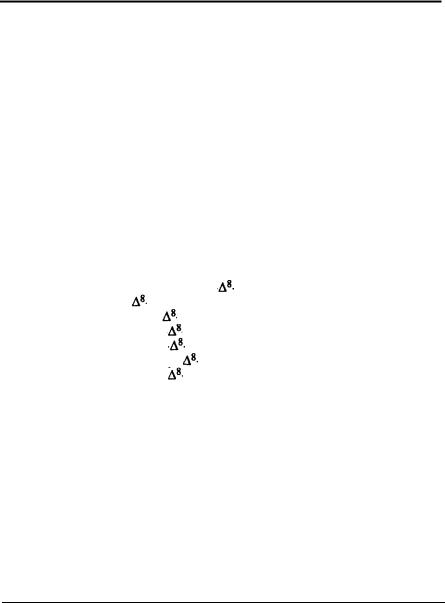
TABLE 6
Selective Pharmacological Profiles of Cannabinoids Analogs
Class 1 - All Cannabinoid Effects
 -THC
-THC
 -THC 11-OH-
-THC 11-OH-  -THC
-THC
S-3'-OH-  -THC
-THC
Class 2 - Weak CNS Depressant Devoid of other Cannabinoid Effects
10-Azido-CBD (4)
10-Sulfhydryl-CBD (5 )
10-Bromo-CBD diacetate(6 )
10-Morpholino-CBD diacetate (10) 10-(N-Methyl-N-propargylamino)CBD (7 ) 10-(N,N-Diisopropylamino)CBD (8 ) 10-[(4-Aminobutyryl)amino]CBD (9 ) CBD
 -THC (33) 11-N-Ethylamino-
-THC (33) 11-N-Ethylamino-  -THC (12)
-THC (12)
11-N-Bis(2-chloroethyl)- |
-THC ( 13 & 14) |
11-Thiol- -THC (15) |
|
11-Thioacetyl- -THC (16)
9-nor-9-Phenyl- |
-THC (17) |
9-nor-9-Benzyl- |
-THC (18) |
9-nor-9-Isopropyld |
-THC (19) |
9-nor- 9 -nButyl- |
-THC (20) |
Class 3 -Potent CNS Depressant Devoid of other Cannabinoid Effects
10-N-Ethylamino-CBD (1 ) 10-N-Propylamino-CBD (2 ) 12ß-amino-  -THC (22) 12ß-ethylamino-
-THC (22) 12ß-ethylamino-  -THC (23)
-THC (23)  -THC (33) (dogs only)
-THC (33) (dogs only)
5'-trimethylammonium-  -THC phenolate (26)
-THC phenolate (26)
Class 4- Selective CNS Depressant Devoid of other Cannabinoid Effects
10-N,N-Bis-chloroethyl-CBD (3 ) - hypothermia, i.v.t. 11-Methylamino-  -THC (11) - hypoactivity 9-nor-9-nButyl-
-THC (11) - hypoactivity 9-nor-9-nButyl-  -THC (20) - hypothermia
-THC (20) - hypothermia
119
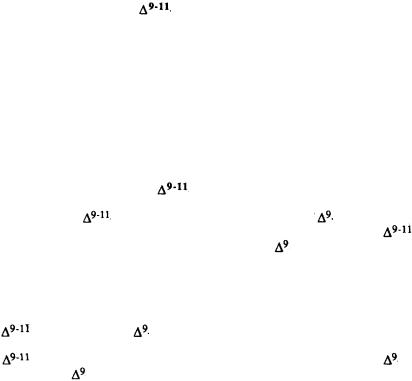
Agonistic Effects of |
-THC in the Mouse, Dog and Monkey |
The exocyclic analog (33) ,  -THC, was investigated extensively as a result of the suggestions of Binder and his colleagues (Binder et al. 1979; Binder and Franke 1982; Semjonow and Binder 1985) that this analog should lack psychoactive properties and would be useful for delineating nonspecific and specific cannabinoid binding in in vitro assays. The pharmacolocal profile of
-THC, was investigated extensively as a result of the suggestions of Binder and his colleagues (Binder et al. 1979; Binder and Franke 1982; Semjonow and Binder 1985) that this analog should lack psychoactive properties and would be useful for delineating nonspecific and specific cannabinoid binding in in vitro assays. The pharmacolocal profile of  -THC in mice is similar to that of
-THC in mice is similar to that of  -THC, even though
-THC, even though  -THC is less potent in all tests (table 4). It appears to be approximately 4, 15, and 11 times less active than
-THC is less potent in all tests (table 4). It appears to be approximately 4, 15, and 11 times less active than  -THC in depressing spontaneous activity, reducing body temperature, and producing antinociception in mice, respectively (Beardsley et al., in press).
-THC in depressing spontaneous activity, reducing body temperature, and producing antinociception in mice, respectively (Beardsley et al., in press).
Antagonistic |
Effects of |
-THC |
|
|
|
|
||
The |
effects of |
-THC |
pretreatment |
on the actions |
of |
-THC in mice, dogs, |
||
and |
monkeys |
have also been studied |
(Beardsley |
et |
al., |
in press). |
-THC |
|
pretreatment did not attenuate any of the effects of |
-THC in mice. Evaluation of |
|||||||
 -THC for cannabinoid antagonistic properties in the dog is hampered by the fact that it has some depressant properties in this behavioral test. However, pretreatment with either 0.5 or 1.0 mg/kg of
-THC for cannabinoid antagonistic properties in the dog is hampered by the fact that it has some depressant properties in this behavioral test. However, pretreatment with either 0.5 or 1.0 mg/kg of -THC 15 min before
-THC 15 min before  -THC does not result in an attenuation of the effects of the latter. One of the most intriuing observations in the monkey tests is the finding that pretreatment with
-THC does not result in an attenuation of the effects of the latter. One of the most intriuing observations in the monkey tests is the finding that pretreatment with
-THC |
attenuates |
-THC-induced ptosis, sedation, ataxia. and |
operant |
behavior in |
monkeys |
(table 5). The importance of this observation is that |
|
-THC produces more than a modest reduction in the effects of |
-THC in |
||
most cases. |
-THC-induced operant suppression is decreased by as much as 25 |
||
times. Although it may be premature to describe this interaction in monkeys as antagonism, two exciting leads emerge. This exocyclic compound suggests further possible alterations in the cannabinoid structure for developing an antagonist, and implies that the monkey may be better suited for characterizing cannabinoid antagonistic activity than other behavioral tests.
SUMMARY
The behavioral effects of cannabinoids are dependent upon numerous variables which include species differences, dose, experimental conditions, etc. The complexity of the cannabinoid behavioral syndrome certainly complicates attempts to establish biochemical correlates. It is for this reason that attempts are being made to develop analogs that exhibit selective behavioral effects. The pharmacological profile of the analogs summarized in table 6 suggests a tentative classification for the cannabinoids. While there are numerous analogs which produce the entire spectrum of cannabinoid effects, only those discussed within this article are grouped in class 1. CBD and many of its analogs appear to be devoid of cannabinoid effects, but they are capable of producing CNS depression at large doses (class 2). It is our working hypothesis that the compounds in class 2 may be altering membrane peturbation in a nonspecific fashion. This latter effect may or may not be related to the psychoactive cannabinoids. Class 3 compounds are potent CNS depressants that appear to lack other effects that are unique to cannabinoids. These analogs are particularly interesting in that they may be altering membrane function in a specific fashion in contrast to nonspecific effects
120
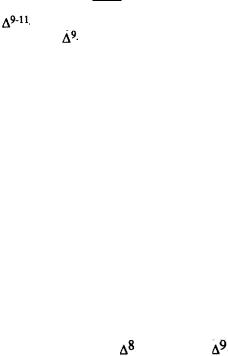
exerted by analogs in class 2. Analogs in class 4 appear to exert selective CNS depression. While the mechanism by which these analogs are producing their effects may be proven to be different from those postulated, it does appear that a classification of cannabinoid effects is possible through structural alterations in the cannabinoid molecule.
REFERENCES
D'Amour, F.E., and Smith, D.L. A method for determining loss of pain sensation. J Pharmacol EXD Ther 72:74-79, 1941.
Beardsley, P.M.; Scimeca, J.A.; and Martin, B.R. Studies on the agonistic
activity of |
-tetrahydrocannabinol in mice, dogs and rhesus monkeys and |
|
its interactions |
with |
-tetrahydrocannabinol. J Pharmaco Exp Ther, in |
press.
Binder, M., and Franke, I. Is there a THC receptor? Current perspectives and approaches to the elucidation of the molecular mechanism of action of the psychotropic constituents of Cannabis sativa L. In: Hucho, F., ed. Neuroreceptors. Berlin: Walter de Gruyter and Co., 1982. pp. 71-80.
Binder, M.; Edery, H.; and Porath, G. Delta-7-tetrahydrocannabinol, a nonpsychotropic cannabinoid: Structure-activity considerations in the cannabinoid series. In: Nahas, G.G., and Paton, W.D.M., eds. Marihuana: Biological Effects. London: Pergamon Press, 1979. pp. 71-80.
Bloom, A.S.; Dewey, W.L.; Harris, L.S.; and Brosium, K.K. 9-nor- 9 ß - OH-Hexahydrocannabinol, a cannabinoid with potent antinociceptive activity: Comparisons with morphine. J Pharmacol Ex Ther 200:263-270, 1977.
Buxbaum, D.M. Analgesic activity of  -tetrahydrocannabinol in the rat and mouse. Psychopharmacology 25:275-280, 1972.
-tetrahydrocannabinol in the rat and mouse. Psychopharmacology 25:275-280, 1972.
Chesher, G.B.; Dahl, C.J.; Everingham, M.; Jackson, D.M.; MarchantWilliams, H.; and Starmer , G.A. The effect of cannabinoids on intestinal motility and their antinociceptive effect in mice. Br J Pharmacol 49:588-594, 1973.
Dewey, W.L.; Harris, L.S.; Howes, J.F.; Kennedy, J.S.; Granchelli, F.E.; Pars, H.G.; and Razdan, R.K. Pharmacology of some marijuana constituents and
two heterocyclic analogues. Nature 226: 1265-1267, 1970. |
|
||
Dewey, W.L.; Harris, |
L.S.; and |
Kennedy, J.S. S ome pharmacological |
and |
toxicological effects |
of 1-trans - |
- and 1-trans- -tetrahydrocannabinol |
in |
laboratory rodents. Arch Int Pharmacodyn 196:133-145, 1972.
Gilbert, P.E. A comparison of THC, nantradol, nabilone, and morphine in the chronic spinal dog. J Clin Pharmacol 21:311S-319S, 1981.
Jorapur, V.S.; Khalil, Z.H.; Duffley, R.P.; Razdan, R.K.; Martin, B.R.; Harris, L.S.; and Dewey, W.L. Hashish: Synthesis and pharmacological activity of s o m e n o v e l a n a l o g s o f c a n n a b i d i o l a n d o x e p i n d e r i v a t i v e s o f  -tetrahydrocannabinol. J Med Chem 28:783-787, 1985.
-tetrahydrocannabinol. J Med Chem 28:783-787, 1985.
Litchfield, L.T., and Wilcoxon, F.A. A simplified method of evaluating dose effect experiments. J Pharmacol Exp Ther 96:99-113,1949.
Martin, B.R. Characterization of the antinociceptive activity of intravenously administered delta-9-tetrahydrocannabinol in mice. In: Harvey, D.J., ed. Marihuana '84, Proceedings of the Oxford Symposium on Cannabis. Oxford: IRL Press, 1985a. pp. 685-691
Martin, B.R. Structural requiremdnts for cannabinoid-induced antinociceptive activity in mice. Life Sci 36:1523-1530, 1985b.
Martin, B.R. Cellular effects of cannabinoids. Pharmacol Rev 38:45-74, 1986.
Martin, B.R.; Dewey, W.L.; Harris, L.S.; Beckner, J.; Wilson, R.S.; and May, E.L. Marihuana-like activity of new synthetic tetrahydrocannabinols. Pharmacol Biochem Behav 3:849-853, 1975.
121
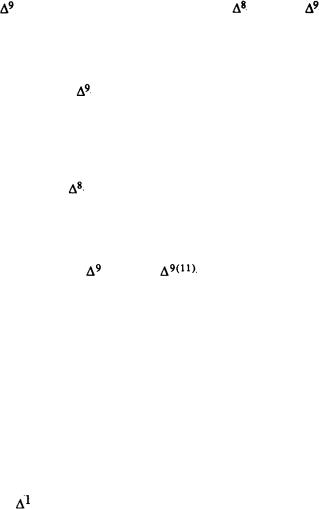
Martin, B.R.; Dewey, W.L.; and Harris, |
L.S. Pharmacological |
activity of |
-THC metabolites and analogs of CBD, |
-THC and -THC. |
In: Agurell, |
S.; Dewey, W.L.; and Willette, R.E., eds. The Cannabinoids: Chemical, Pharmacologic and Therapeutic Aspects. New York: Academic Press, 1984a.
pp. |
523-544. |
|
|
|
|
|
|
Martin, |
B.R.; Kallman, |
M.J.; Kaempf, G.F.; |
Harris, L.S.; |
Dewey, |
W.L.; |
and |
|
R a z d a n , |
R . K . |
P h a r m a c o l o g i c a l |
potency |
of |
R- |
a n d |
|
S-3'-hydroxy- |
-tetrahydro- cannabinol: Additional structural requirement for |
||||||
cannabinoid activity. Pharmacol Biochem Behav 21:61-65, |
1984b. |
|
|
||||
Noyes, J.R.; Brunk, S.F.; Avery, D.H.; and Canter, A. The analgesic properties of  -tetrahydrocannabinol and codeine. Clin Pharmacol Ther 18:84-89, 1975.
-tetrahydrocannabinol and codeine. Clin Pharmacol Ther 18:84-89, 1975.
Nye, J.S.; Seltzman, H.H.; Pitt, C.G.; and Snyder, S.H. High-affinity cannabinoid binding sites in brain membranes labeled with [3H]5'-trimethyl
ammonium |
-tetrahydrocannabinol. J Pharmacol Exp Ther 234:784-791. |
1985. |
|
Olson, J.L.; |
Makhani, M.; Davis, K.H.; and Wall, M.E. Preparation of |
 -teuahydrocannabinol for intravenous injection. J Pharm Pharmacol 25:344, 1973.
-teuahydrocannabinol for intravenous injection. J Pharm Pharmacol 25:344, 1973.
Semjonow, A., and Binder, M. Generalization of the discriminative stimulus
properties of |
-THC to |
-THC in rats. Psychopharmacology |
85:178-183, 1985. |
|
|
Sofia, R.D., and Barry, H. The effects of SKF 525-A on the analgesic and barbiturate-potentiating activity of  -tetrahydrocannabinol in mice and rats. Pharmacology 27:223-236, 1983.
-tetrahydrocannabinol in mice and rats. Pharmacology 27:223-236, 1983.
Sofia, R.D.; Nalepa, S.D.; Harakal, J.J.; and Vassar, H.B. Antiedema and analgesic properties of  -tetrahydrocannabinol (THC). J Pharmacol Exp Ther 186:646-655, 1973.
-tetrahydrocannabinol (THC). J Pharmacol Exp Ther 186:646-655, 1973.
Walton, R.P.; Martin, L.F.; and Keller, J.H. The relative activity of various purified products obtained from American grown hashish. J Pharmacol Exp Ther 62:239-251, 1938.
W i l s o n , R . S . ; M a y , E . L . ; M a r t i n , B . R . ; a n d D e w e y , W . L . 9-nor-9-Hydroxyhexahydrocannabinols. Synthesis, some behavioral and analgesic properties, and comparison with the tetrahydrocannabinols. J Med
Chem 19:1165-1167, 1976
Zitko, B.A.; Howes, J.F.; Razdan, R.K.; Dalzell, B.C.; Dalzell, H.C.; Sheehan,
J.C.; |
Pars, H.G.; Dewey, |
W.L.; and Harris, L.S. |
Water-soluble derivatives |
of |
-tetrahydrocannabinol. |
Science 177:442-444, |
1972. |
ACKNOWLEDGMENTS
The research described herein was supported by a research grant (DA-03672) and a training grant (DA-07027) from the National Institute on Drug Abuse.
AUTHORS
Billy R. Martin, Ph.D
David R. Compton, Ph.D
Patrick J. Little, B.S.
Thomas J. Martin, B.S.
Patrick M. Beardsley, Ph.D
Department of Pharmacology and Toxicology, Box 613 Medical College of Virginia/Virginia Commonwealth University Richmond, Virginia 23298-0001
122
